|
NOTES AND EXTRACTS
ON THE HISTORY OF THE
LONDON
& BIRMINGHAM
RAILWAY
CHAPTER 13
THE RAILWAY IN OPERATION
THE EARLY DAYS

|
A Bury engine heads up a mixed
train. The carriage second from the end is a 2nd-class day coach.
Note the guards seated
outside, a leftover from stage coaching days. Among other duties
they operated the carriage brakes.
“When railways were first established,
every living being gazed at a passing train with astonishment and
fear; ploughmen held their breath; the loose horse galloped from it,
and then, suddenly stopping, turned round, stared at it, and at last
snorted aloud. But the ‘nine days’ wonder’ soon came to an
end. As the train now flies through our verdant fields, the cattle
grazing on each side do not even raise their heads to look at it;
the timid sheep fears it no more than the wind; indeed, the
hen-partridge, running with her brood along the embankment of a deep
cutting, does not now even crouch as it passes close by her. It is
the same with mankind. On entering a railway station we merely
mutter to a clerk in a box where we want to go ― say ‘How much?’ ―
see him horizontally poke a card [an Edmondson
ticket] into a
little machine that pinches it ― receive our ticket ― take our place
― read our newspaper ― on reaching our terminus, drive away
perfectly careless of all or of any one of the innumerable
arrangements necessary for the astonishing luxury we have enjoyed.”
The London Quarterly Review,
No. CLXVII. (1848).
The London and Birmingham Railway was opened in stages as
construction progressed. A service between Euston and Boxmoor (now
Hemel Hempstead station), calling at the
intermediate stations of Harrow and Watford, commenced on 20th July 1837:
LONDON AND BIRMINGHAM RAILWAY.
PARTIAL OPENING OF THE LINE, 1837.
The public are informed that on and after Thursday, the 20th inst.,
the Railway will be opened for the conveyance of Passengers and
Parcels to and from London and Boxmoor, including the intermediate
stations of Harrow and Watford.
First class coaches carry six passengers inside, and each seat is
numbered.
Second class coaches carry eight passengers inside, and are covered,
but
without lining, cushions or divisions, and the seats are not
numbered.
Third class coaches carry four passengers on each seat, and are
without
covering.
The following, until further notice, will be the times for departure
of the
Trains on every day except Sundays. |
|
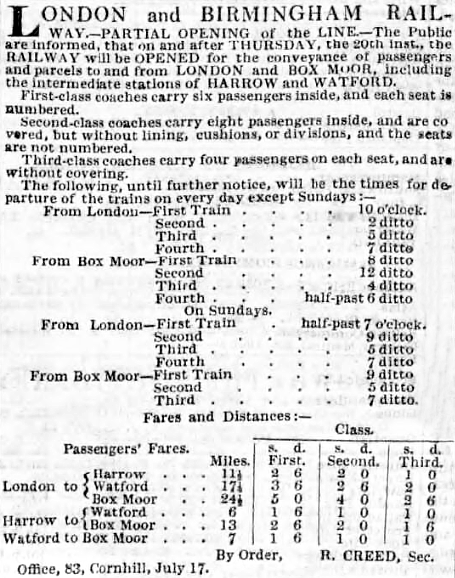 |
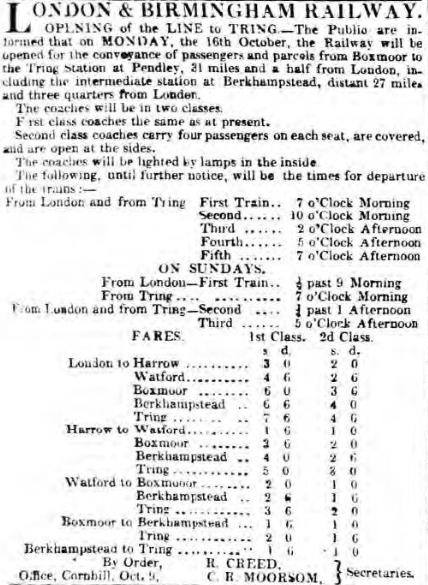 |
|
The London
Standard, 19th July 1837. |
The Morning Post,
16th October 1837 |
|
On the 16th
October the service was extended to Tring; then, on the 9th April, to a temporary station at Denbigh Hall (Wolverton), a road coach shuttle service being used to
bridge the 38-mile gap to Rugby from where, on the same day, a
service to Birmingham had also commenced. On the 17th September
1838, the line was opened throughout, the temporary station at
Denbigh Hall being closed shortly afterwards. |
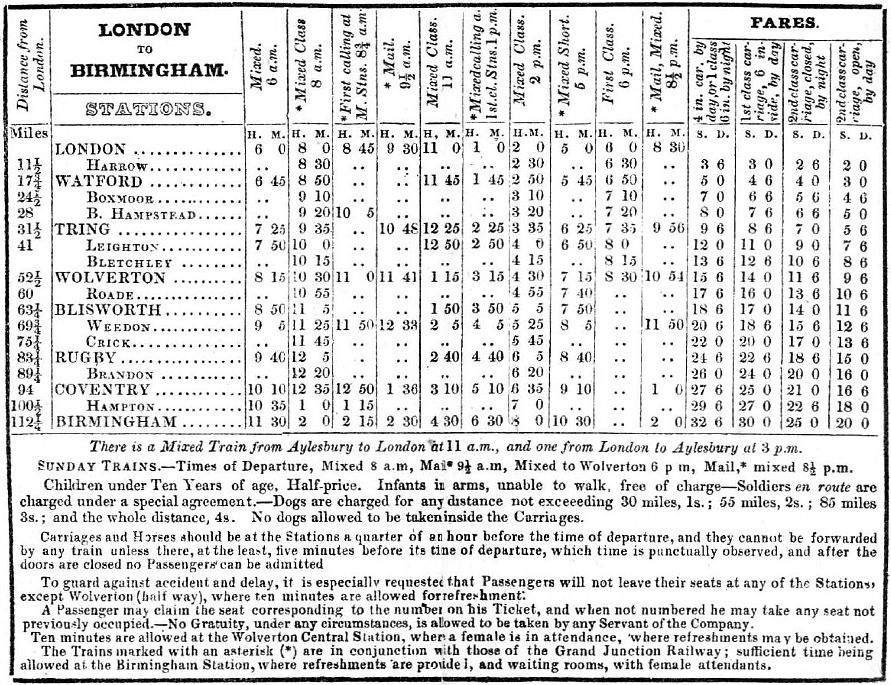
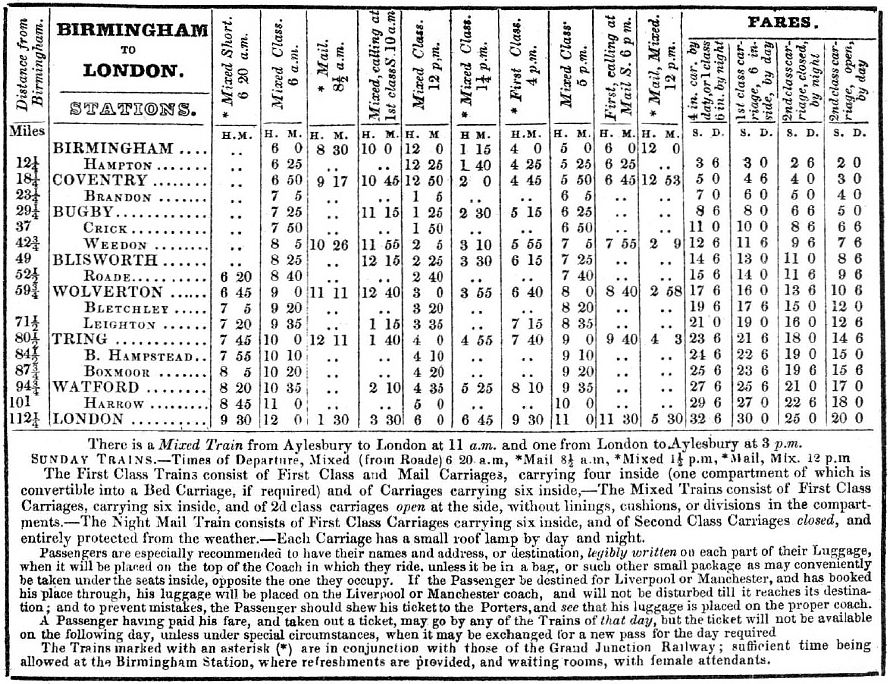
Bradshaw’s London and Birmingham Railway
timetable for 1839.
2nd class passengers did not have a comfortable journey,
especially
during the day when the carriages were open-sided.
|
It is interesting to note that although the Company did
not at first offer a third-class service, third-class tickets
were
offered for the opening of the line to Boxmoor. At a time when
agricultural labourers were supporting their families on
between ten and fifteen shillings a week, at 2s. 6d, even a
third-class ticket into London would have been
prohibitively
expensive. By the time the line was extended to Tring,
Company advertising shows that
third-class fares were no longer available, the cheapest Boxmoor to
Euston (single) fare by then having increased to 3s. 6d. It is plainly
evident that the Company
had no interest in attracting the labouring-classes who had to
await W. E. Gladstone’s ‘Railway Regulation Act’ of 1844 for a
service ― the ‘parliamentary train’ ― that was cheap enough to
enable working men to use the railways to find work:
“At this period third class passengers
fared very badly, in fact, much worse than cattle do nowadays; far
from being encouraged, they were tolerated as a necessary nuisance
and that was all; but the Manchester and Birmingham Railway led the
way to better things, and from the first treated its third-class
patrons in a very generous way. Third class accommodation was
provided on all the twelve trains which performed the journey each
way daily at a rate of some twenty-five miles per hour. This was a
great concession, for third class passengers were at this date
generally restricted to one or two of the slowest trains of the day,
which started at some unearthly hour and performed the journey
between its innumerable halts at a leisurely crawl.”
The History of the London and
North-Western Railway, Wilfred L. Steel (1914).
In January 1842, the railway department of the Board of trade sent
out a circular letter to railway companies asking, among other
questions, “Whether third-class or other passengers-carriages go
with trains partly composed of luggage-waggons.” In most cases
the returns indicated that third-class passengers were conveyed by
the same trains as other passengers, but upon the London and
Birmingham Railway they were conveyed by a special train along with
cattle, horses and empty return-waggons. [1]
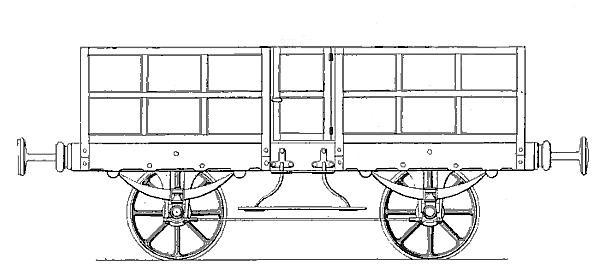
A third-class carriage
from the earliest days of railway travel.
“The
seats are so arranged that the whole space of the
carriage is accessible by a single door. Two doors are,
however, provided, one opposite to the other, and
situated in the middle of the sides of the carriage.
This carriage is adapted to hold about thirty-two
persons. The carriages, which were established on most
of the English railways under an order in Parliament,
and hence called
‘Parliamentary’
or ‘Government’
carriages, closely resemble the one here shown in the
position of the doors and arrangement of the seats, but
differ from it in accordance with the Parliamentary
order in being wholly enclosed, the sides being
continued upwards and roofed over and having two or more
small glazed openings on each side.”
The Practical Railway
Engineer, G. D. Dempsey (1855)
|
THE THIRD-CLASS
TRAVELLER’S
PETITION
From Punch (magazine)
|
Pity the sorrows of a third-class man,
Whose trembling limbs with snow are whitened
o’er,
Who for his fare has paid you all he can:
Cover him in, and let him freeze no more!
This dripping hat my roofless pen bespeaks,
So does the puddle reaching to my knees;
Behold my pinch’d red nose—my shrivell’d
cheeks:
You should not have such carriages as these.
In vain I stamp to warm my aching feet,
I only paddle in a pool of slush;
My stiffen’d hands in vain I blow and beat;
Tears from my eyes congealing as they gush.
Keen blows the wind; the sleet comes pelting
down,
And here I’m standing in the open air!
Long is my dreary journey up to Town,
That is, alive, if ever I get there.
Oh! from the weather, when it snows and
rains,
You might as well, at least, defend the poor;
It would not cost you much, with all your
gains:
Cover us in, and luck attend your store. |
|
Today, the Railway Regulation Act is remembered mainly for its requirement that:
one train ― which became known as the parliamentary or
government train ― with provision for carrying third-class passengers, should
run on every line, every day, in each direction, stopping at every
station;
the fare should be 1d. (½p) per mile;
its average speed should not be less than 12 miles per hour;
third-class passengers should be protected from the weather and be
provided with seats;
third-class passengers should be allowed to take up to 56 lbs of
luggage with them, free of charge.
In his lines in the operetta, The Mikado, the lyricist W. S.
Gilbert satirized this slow and inconvenient form of travel thus:
The idiot who, in railway
carriages,
Scribbles on window panes,
We only suffer,
To ride on a buffer,
In parliamentary trains. |
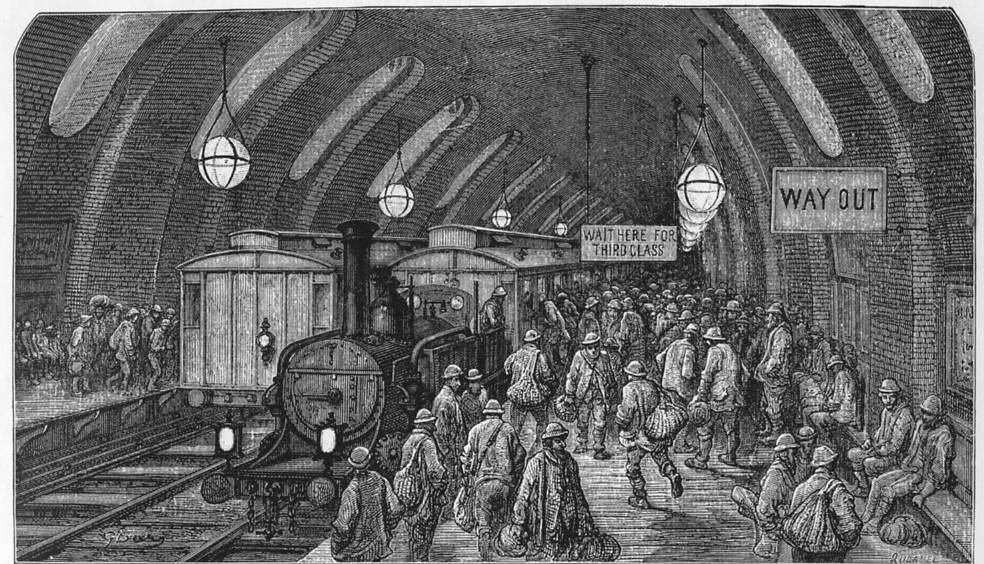
The Workmen’s Train, an
illustration by Gustave Doré
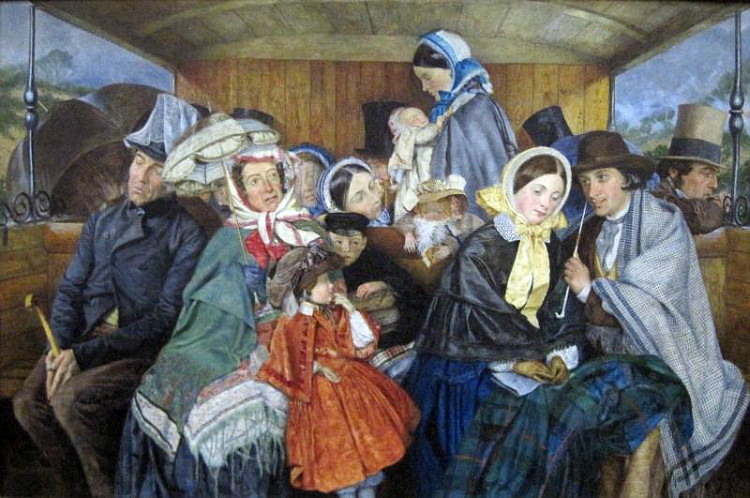
Third-class.
In return for this concession, the railway operator was exempted
from paying duty on third-class passengers.
However, train fares remained high, not only for the working classes,
but for many potential first and second-class travellers. The
Directors eventually realised that the Company would profit by
encouraging more people to travel by train, and that this could best
be achieved by reducing ticket prices across the board:
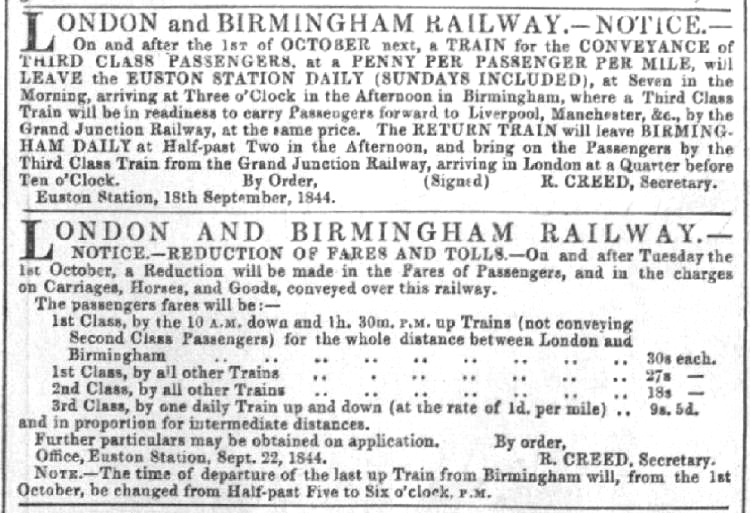
Illustrated London News,
12th October 1844.
Fare reductions were made, and a couple of years later the outcome was reported to Parliament by
Richard Creed, the Company Secretary:
Q ― “The Committee understand that the London
and Birmingham Railway Company have at different times made
reductions in their fares and charges; can you state the particulars
of them? ―
A ―
In September, 1844, the fares through, between London and
Birmingham, were 32s 6d for the mail train; 30s for the ordinary
first class; for the second class 25s and 20s; and for the third
class 14s.
In October, 1844, they were 30s and 27s for the first class; for the
second class 18s; and for the third class 9s 5d.
In April, 1845, they were for the first class 30s, 27s, and 23s; for
the second class 18s and 16s; and for the third class 9s 5d.
In May, 1845, we reduced to 27s for the express; and 23s and 20s for
the first class; the second class to 17s and 14s; and the third
class the same.
In January this year [1846] the
first class were reduced to 25s for the express train; and 20s for
the ordinary first class; 14s the second class; and the third class
a penny a mile, 9s 5d.
In addition to the above reductions, on the 1st of January, 1845,
day tickets were issued at one-third less than the regular fares; so
that, while in 1844 a passenger from London to Birmingham and back
paid 65s or 60s for the first class, and 50s or 40s for the second
class, he now pays only 26s 6d for the first class and 18s 6d for
the second class.
Q ―
“What is the extent of the difference between the prices charged
originally and the present prices? A ― It is exactly one third
reduction.
Q ―
“Have those reductions been attended in any instance with a loss of
revenue? A ― The reductions on the first class in the half year ending
30th of June, 1844, were 17¼ per cent, and it caused an increase in
the number of passengers of 19½
per cent. In the second class it was 26 3/5 per cent reduction in
the fares, and there was an increase in the number of passengers of
61 1/5 per cent. In the third class the reduction in the fares
was 33⅓ per cent, and the
increase in the number of passengers 259 per cent. That is the
effect of the reductions in the half years ending the 30th June,
1844, and the 30th June, 1845.”
Evidence given by Richard Creed to
The Committee on Railway Acts Enactments (26th June 1846).
Points to note are the appearance of the cheap day return and the
quite phenomenal increase in third-class travel ― much more so than
of first or second-class ― apparently brought about by reduced
fares, although the introduction of covered third-class carriages
probably played a part.
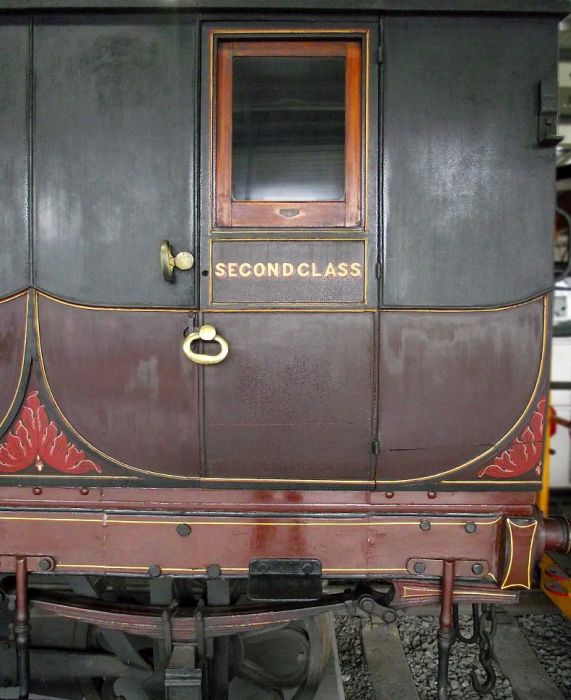
|
Stockton and Darlington
Railway 2nd-class compartment.
This carriage had
compartments for both 1st and 2nd-class passengers.
Comfortable padded seating was provided in 1st-class ―
which had additional windows ― wooden benches in 2nd.
As on the stagecoaches of the time, passengers’ luggage
was stored on the roof while the guard occupied a
rooftop seat (in all weathers). |
Another potential cost-saving
for the travelling public was that railway companies carried
children under the age of ten free, or for a reduced fare, although
this concession sometimes gave rise to debate, as illustrated in
this Punch cartoon from later in the century:
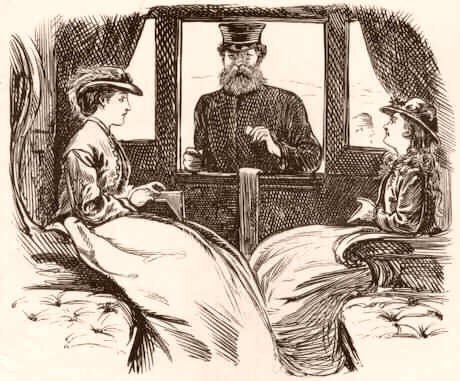
|
Guard (taking
half-price ticket).
Dignified Little One. |
“Surely
Miss, that young lady is over ten; are you not Miss?”
“Pray,
are you not aware Guard, that it is extremely rude to
ask a lady her age?” |
To return to what the Company considered its ordinary business, the original timetable listed
eight trains a day in each direction, of which one terminated at
Wolverton. The two daily mail trains were the expresses of their
age, their timings being regulated by the Postmaster General, for
The Royal Mail soon recognised the potential that railways
offered for streamlining the nation’s postal service. Mail was first carried
by train on the Liverpool and Manchester Railway in 1830. In 1838,
the Grand Junction Railway introduced the first travelling post office
between Birmingham and Warrington using a converted
railway horse-box operated by three mail sorters. |
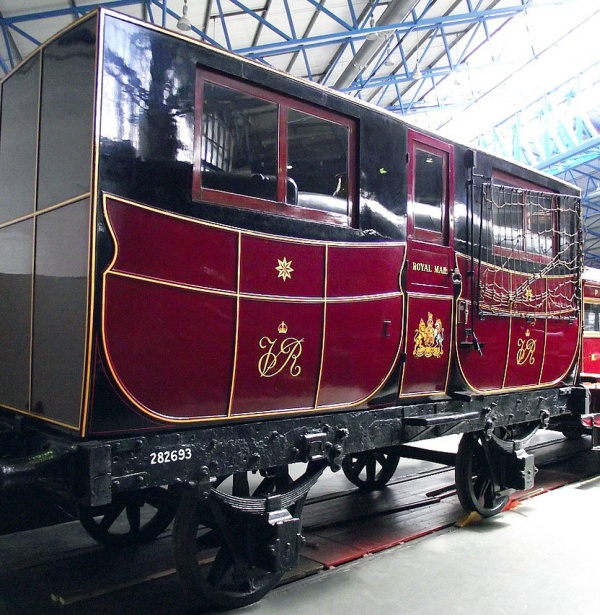
Grand Junction Railway travelling
post office (replica), National Railway Museum, York.
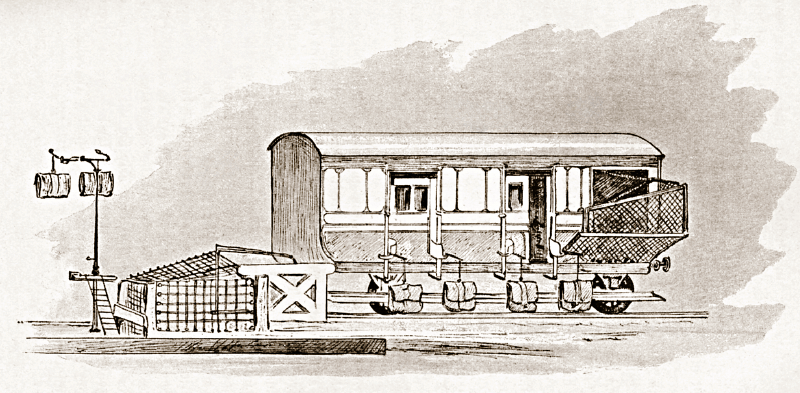
Equipment (ca. 1890) used to transfer
mail bags to and from a train travelling at speed.
|
Also in 1838, the London and Birmingham Railway introduced the first lineside
apparatus designed to pick up and drop down mail from trains travelling at speed. This was followed in 1848 by an improved system, with moveable nets
fixed to both train and the lineside apparatus. The ‘Travelling Post Office’, as
it became known, was so successful that it gave rise to the
‘Railways (Conveyance of Mails) Act’ later that year, which required
all railway companies to carry mail under the direction of
the . . . .
“. . . . Postmaster General, by Notice in
Writing under his Hand delivered to the Company of Proprietors of
any such Railway, to require that the Mails or Post Letter Bags
shall from and after the Day to be named in any such Notice (being
not less than Twenty-eight Days from the Delivery thereof) be
conveyed and forwarded by such Company on their Railway, either by
the ordinary Trains of Carriages, or by special Trains, as Need may
be, at such Hours or Times in the Day or Night as the Postmaster
General shall direct, together with the Guards appointed and
employed by the Postmaster General in charge thereof, and any other
Officers of the Post Office; and thereupon the said Company shall,
from and after the Day to be named in such Notice, at their own
Costs, provide sufficient Carriages and Engines on such Railways for
the Conveyance of such Mails and Post Letter Bags to the
Satisfaction of the Postmaster General, and receive, take up, carry,
and convey such ordinary or special Trains of Carriages or
otherwise, as Need may be, all such Mails or Post Letter Bags as
shall for that Purpose be tendered to them . . . . ”
Cap. XCVIII., An Act to provide
for the Conveyance of the mails by railways. R.A. 14th August
1838.
In the first London and Birmingham Railway timetable, the
day mail departed from Euston at 9.30 a.m. and from Birmingham at
8.30 a.m. The journey took five hours, calling at Tring, Wolverton, Weedon, and Coventry; the night mail took
30 minutes longer. Additionally, there was one first-class train in
each direction ― also a five hour journey ― stopping additionally at Watford, Blisworth and Rugby,
and five mixed
trains, which performed the journey in five and a half hours stopping at
all stations (i.e. including Harrow, Boxmoor, Berkhamsted,
Leighton, Bletchley, Roade, Blisworth, Crick, Brandon and Hampton). However, arriving at a station in time to catch a scheduled train
depended on knowing
the difference between ‘local time’ and that advertised in the railway timetable.
Today, clocks across Great Britain are set
to either Greenwich Mean Time or
British Summer Time depending on the time of year, but this wasn’t always so. Before the
electric telegraph could be used to broadcast accurate time
signals nationwide, time had to be determined locally, midday being
when the Sun appeared on the local meridian. But taking account
of the
speed of the Earth’s rotation, for every 15º of longitude between
two points there is a
difference of one hour in the time when midday occurs. For example,
the Sun is on the meridian (i.e. midday) of Birmingham some 7
minutes and 15 seconds later than in London, and this difference was
reflected in how clocks were set locally. Thus, for stations
along their lines railway companies published the
differences between local time and the times that appeared both in their timetables
and on their station clocks:

Cornish’s Guide and Companion to
the London and Birmingham Railway (1839).
On 22nd September 1847, the Railway Clearing House (dealt with
below) decreed that “GMT be adopted at all
stations as soon as the General Post Office permitted it”.
Then, on the London and North Western . . . .
“. . . . as soon as the railway was opened through from London to
Holyhead in 1848 the company enforced standardisation according to
Greenwich time. Each morning an Admiralty messenger carried a
watch bearing the correct time to the guard on the down Irish Mail
leaving Euston for Holyhead. On arrival at Holyhead the time
was passed on to officials on the Kingstown boat who carried it over
to Dublin. On the return mail to-Euston the watch was carried
back to the Admiralty messenger at Euston once more. This was
a practice which was taken over from the days of the mail coach and
carried on until the outbreak of the Second World War, by which time
the spread of telegraphy and the radio had long since rendered it
superfluous. Scottish independence was further undermined by
the irresistible spread of the railway. The Caledonian Railway
felt obliged, for reasons of business efficiency, to adopt Greenwich
time from the 1st December 1847.”
From The
Transport Revolution from 1770, Philip S. Bagwell (1974).
By
1855, when Greenwich time signals could be transmitted throughout the
telegraph system, it was estimated that 98 percent of Great Britain’s towns and cities were
synchronised with GMT. However, it was not until 2nd August 1880
that a unified standard time for the whole of Great Britain achieved
legal status:
“Whenever any expression of time occurs in
any Act of Parliament, deed, or other legal instrument, the time
referred to shall, unless it is otherwise specifically stated, be
held in the case of Great Britain to be mean Greenwich time, and in
the case of Ireland, mean Dublin time.”
From The Statutes (Definition of
Time) Act, 1880, 43 & 44 Vict. c. 9.
――――♦―――― |
|
RETURNS TO INVESTORS
The Company issued its first circular to
prospective investors in January, 1831, in which were published the
Directors’ initial
estimates of construction costs and the revenues they expected from passenger and goods traffic:
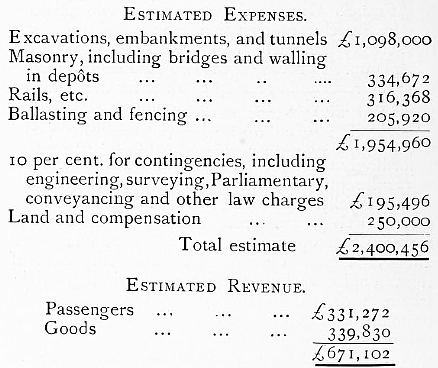
Passenger traffic got off to a good start,
for even on the partial opening of the line sheer curiosity .
. . . .
“. . . . brought thousands of
passengers; but in the third class open carriages the dust from the
roofs of the tunnels and the newly made line, and the hot cinders
from the engines, gave them rough travelling. On October 16th, 1837,
the line was further opened to Tring, and on April 9th, to Denbigh
Hall. The stage coaches and mails were conveyed on carriage-trucks
to Denbigh Hall, thence by road to Rugby, and the rest of the
journey by rail to Birmingham. The stations were enlivened by
the sound of the bugle, but the coach-guards were disgusted with
their outside ride on the railway. The railway guards also had an
unpleasant time, for, adhering to old usage they too rode outside on
the top of the carriage, where, amidst other disagreeables, their
clothes sometimes caught fire. The roadside stations were enclosed
with lofty iron railings, within which the passengers were
imprisoned until the train arrived; they were then permitted to rush
out to take their places, for which they sometimes had to join in a
free fight . . . . The clatter caused by the stone blocks, which
were used before the wooden sleepers replaced them, added to the
unpleasantness of the journey. Thus the success of the new mode of
conveyance was not then established in the popular mind; and coach
proprietors and others interested in its expected failure, still
hoped on, and in many cases lost money by their lingering belief in
the old system.”
Fifty Years on the London and
North-Western Railway, David Stevenson (1891).
Contrary to what the Directors expected, the
benefits of faster railway conveyance were not so quickly recognised
by the shippers and consignees of goods as they had been by passengers, where the general trend was that more journeys
by rail were being made than
had previously been made by road:
“The attention of the directors has been
sedulously given to the means by which the merchandise and cattle
traffic may be extended, and they are taking such measures as appear
to them conducive to this end. The proprietors will, however,
recollect that this description of traffic will be much longer in
accommodating itself to the railway than the passenger traffic.”
Half-yearly meeting reported in
The Morning Post, 8th February 1840.
During the Railway’s first complete year of operation ― and despite the “rough travelling” and the “clatter caused by
the stone blocks” ―
passenger traffic earned revenue of £500,000, well above
the Company’s 1831 projection (£331,272). However, goods
traffic did not fare nearly so well, with revenue of
£90,000 falling well below estimate (£339,830). Some
types of freight business had at first to be won from the canal
companies and from other
sources ― for instance cattle, later to become a profitable source of freight
revenue, were driven into London along the
high roads. In 1819, the travel writer John Hassell, while visiting
the Grand Junction Canal at Tring, reported seeing . . . .
“. . . . herds of cows grazing, and
observed a fresh drove of sucklers with their calves coming up to
remain for the night, and we found, upon enquiry, that this inn
[The Cowroast Inn] was one of
the regular stations for the drovers halting their cattle for
refreshment; hence I should suppose, the proper name is the Cow
Rest, or resting place of those animals, for along the road, and all
the way through the breeding and grazing parts of Bucks,
Bedfordshire, and Northamptonshire, there is a perpetual supply of
cows passing to the Capital . . .”
A Tour of the Grand Junction Canal
in 1819, John Hassell.
The Board did not at first consider deadweight freight, such as coal and stone,
to be profitable, these being commodities which they felt more appropriate to canal
transport where they had been the staple fare from the very start. But attitudes, especially to coal, gradually changed, and . . . .
“. . . . for more than a hundred years after 1850
the movement of coal was the bread and butter of British railways,
the tonnage carried being always well over half the total volume of
freight traffic. In 1865, for instance, the quantity of coal carried
by rail was 50 million tons compared with 13 million tons of other
minerals (principally iron) and nearly 32 million tons of general
merchandise.”
The Transport Revolution 1770-1985,
Philip S. Bagwell (1974).
Indeed, trainloads of coal were later to choke the line into London,
leading, in 1859, to a third track being laid between Willesden and
Bletchley in an attempt to relieve the congestion.
|
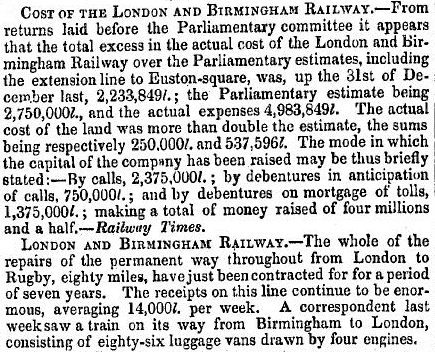 |
|
The
Weekly Herald, 27th October
1839 |
Other than the traffic figures, an item referred to in the Secretary’s Report for
the first year of operation was
the cost of repairs to stations and the permanent way, in
particular, the continuing expense of repairing damage dues to
slippage ― “. . . . the late extraordinary and continued rains,
acting upon works of great magnitude and recent formation, caused a
more than ordinary subsidence of all principal embankments . . . .” In an effort to reduce its maintenance costs, the Board had outsourced
civil engineering repairs at a fixed price per mile, but there were “a few embankments and cuttings,
which, from their peculiar liability to slips, could not well be
contracted for at present” and they were excluded from this arrangement.
In these cases repairs would “by the conditions of the contract, to be
paid for as extras for a limited period.” Indeed, the line was to
experience further substantial slips, such as that in
Bugbrooke
cutting in 1842.
At the half-yearly meeting held in February 1841, the Secretary was
able to report that traffic for the six months ended December 1840
exceeded that of any preceding half-year, and that revenue of
£406,040 was £61,846 more than in the preceding period. Despite the
initially poor performance of goods traffic, the dividend paid to
shareholders for 1839 was just over 8⅓%;
this increased to 8⅞% for 1840, 10 per cent for 1841, and in 1842 it
peaked at just over 11 per cent (£100 ordinary shares were
then changing hands for as much as £223) before dropping back to 10%
for 1843. |
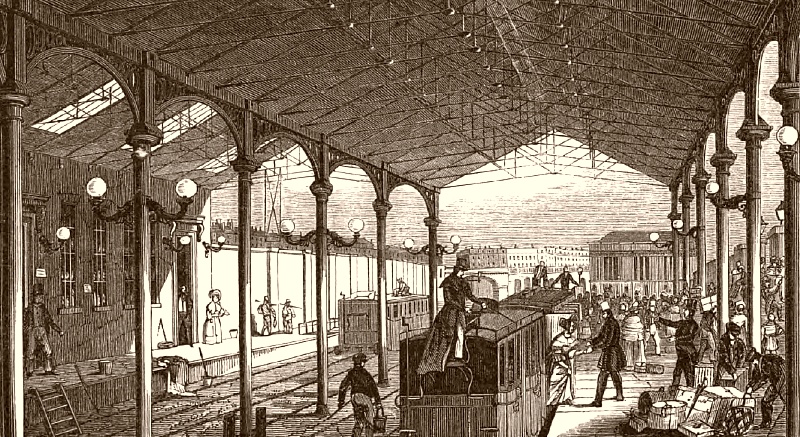
The arrival platform at Euston,
c.1839.
――――♦――――
SAFETY AND REGULATIONS
Bedsides turning in a good profit for its shareholders, the Railway was also
achieving a good safety record, which undoubtedly helped encourage
passenger travel in an age when for most its use was a
considerable step into the unknown. Take, for example, the
fear of passing in a train through a tunnel, which appears to have
caused some prospective passengers great unease to the extent that
the Company felt obliged to obtain several suitably qualified
professional opinions:
“Great prejudice once existed against
tunnels, arising entirely from ignorance; and the directors in order
to quiet the minds of the public, had a special visit to the
Primrose-hill Tunnel made by Drs, Paris and Watson, Surgeons
Lawrence and Lucas, and Mr. Phillips the Lecturer on Chemistry ― the
object being to ascertain the probable effect of such a tunnel on
the health and feelings. The atmosphere of the tunnel was found to
be dry, of an agreeable temperature, and free from smell. The lamps
of the carriages were lighted; and in their transit inwards, and
back again to the mouth of the tunnel, the sensation experienced was
precisely that of travelling in a coach by night, between the walls
of a narrow street. The noise did not prevent easy conversation, nor
appear to be much greater in the tunnel than in the open air.
Judging from this experiment, and knowing the ease and certainty
with which thorough ventilation may be effected, these gentlemen
were decidedly of opinion that no danger occurred in passing through
well-constructed tunnels; and that the apprehensions which had
been expressed, that such tunnels are likely to prove detrimental to
the health and unpleasant to travellers, were perfectly futile and
groundless; and to these opinions they all signed their names.”
The London and Birmingham
Railway, Roscoe and Lecount (1839).
Regardless of the travelling public’s fear of the unknown,
during the Railway’s first year of operation there had been no
serious accidents to passengers, which the Secretary attributed in
his half-yearly report
to the careful observance of the Company’s well considered “regulations”:
“In referring to the
progressively-increasing traffic of the railway, as evinced by the
half-yearly reports, the directors may be allowed to notice the
gratifying fact, that out of 1,483,123 passengers, conveyed on an
average sixty-five miles and a quarter each, from the 17th
September, 1838, to the 31st December last, according to the Stamp
Office returns, not one accident attended with loss of life or limb
to a passenger has occurred, although during the whole of this
period the works were undergoing those extensive repairs which are
inseparable from great excavations and embankments, and requiring
the frequent passage along the line of trains heavily laden with
materials. If, then, under these circumstances of disadvantage, the
directors are enabled to exhibit results which in the infancy of the
undertaking could only have been attained by regulations well
considered, and, with few exceptions, carefully observed, it must be
admitted that railways afford ample assurance for the safety of
travelling, and that the London and Birmingham line posses resources
adequate to any extent of traffic.”
Half-yearly meeting reported in
The Morning Post, 13th February 1841.
In the opinion of W. L. Steel, historian of the London and
North-Western Railway, the Company’s regulations
“were somewhat severe”:
“At all the stations on the line was exhibited the following
notice: ‘The public are hereby informed that all the company’s
servants are strictly enjoined to observe the utmost civility and
attention towards all passengers; and the directors request that any
instance to the contrary may be noted by the offended party in a
book kept at each station for that purpose, and called the
Passengers’
Note Book.’
But although the company’s servants were thus ‘strictly
enjoined to observe civility,’
the passengers were by no means without obligations which they had
to carry out, for the company’s bye-laws were both numerous
and stringent. The company announced that ‘upwards of 200 men
are sworn in as special constables and policemen to enforce a proper
attention to the rules of the establishment.’
The rules of the establishment were somewhat severe, and it was some
time before the force of competition caused them to be relaxed; for
instance, on no account were persons allowed on the platform to see
their friends off, dogs were only conveyed at the minimum charge of
ten shillings, whilst there was a rule for preventing the
smoking of tobacco and the commission of other nuisances.”
The History of the London and
North-Western Railway, Wilfred L. Steel (1914).
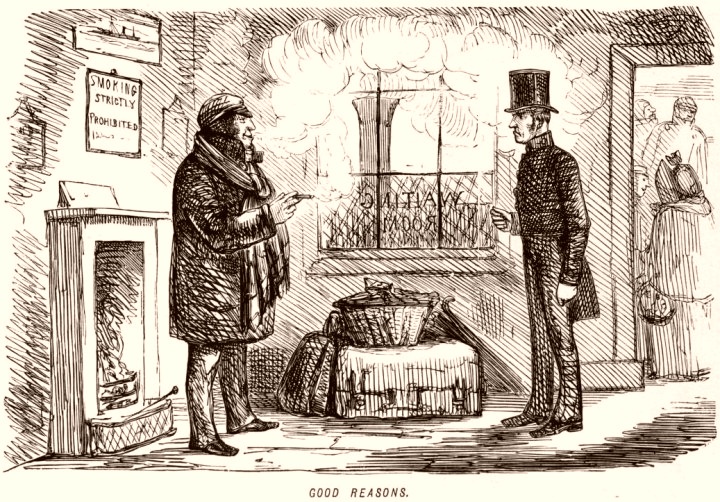
|
Railway Official.
“You’d better not smoke, Sir!”
Traveller. “That’s what my friends say.”
Railway Official. “But you musn’t smoke, Sir!”
Traveller. “So my doctor tells me.”
Railway Official (indignantly). “But you shan’t
smoke, Sir!”
Traveller. “That’s what my wife says.”
(From Punch) |
The “rules of the establishment”
that Steel refers to
were derived from the 1833 Act, which gave to the Company . . . .
“. . . .
full power and authority
from time to time to make such Bye-laws, Orders, and Rules, as to
them shall seem expedient for the good government of the Officers
and Servants of the said Company, and for the regulating the
proceedings, and reimbursing the expenses of the said Directors; and
for the management of the said undertaking in all respects
whatsoever; and from time to time to alter or repeal such Bye-laws,
Orders, and Rules, or any of them, and to make others and to impose
and inflict such reasonable fines and forfeitures upon all persons
offending against the same, as to the said Company shall seem meet .
. . .”
Section CLIV., 3 Gulielmi IV. Cap xxxvi., R.A. 6th
May 1833.
. . . . under which authority were published a set of bye-laws,
which, despite Steel’s
reservations, seem no more onerous than those of today ―
indeed, the smoking ban, both on trains and on station premises,
was years ahead of its time, while the
absence of a guard’s van on today’s
trains and the very limited space available on luggage racks imposes
its own restriction on the amount of
“Luggage
accompanying a Passenger”.
The regulations were often
reproduced in a condensed form in the numerous railway travel guides of the day,
and if they did not represent an attention-gripping read, at least
an attempt to read them probably induced a suitably soporific
remedy to a monotonous journey:
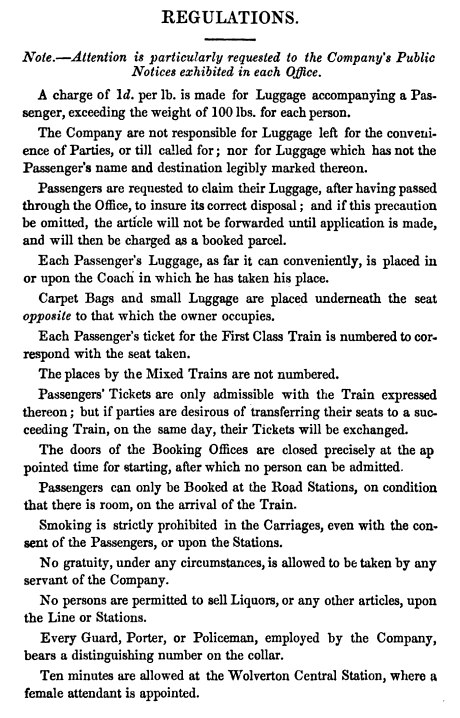
The London and Birmingham Railway
Regulations, c. 1839.
These Regulations were condensed from the “Bye-laws”
at Appendix I.,
which were also reproduced in some of the railway travel guides.
――――♦――――
CARRIAGES AND PASSENGERS
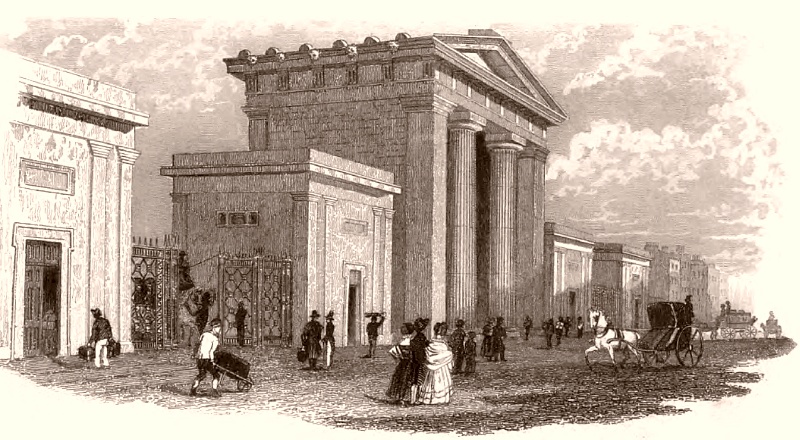
The entrance to Euston Station . . . .
“. . . . On that great covered
platform, which with others adjoining it, is lighted from above by
8,797 square yards (upwards of an acre and three quarters) of plate
glass, are to be seen congregated and moving to and fro in all
directions, in a sort of Babel confusion, people of all countries,
of all religions, and of all languages. People of high character, of
low character, of no character at all. Infants just beginning life ―
old people just ending it. Many desirous to be noticed ― many, from
innumerable reasons, good, bad, and indifferent, anxious to escape
notice. Some are looking for their friends ― some suddenly turning
upon their heels, are evidently avoiding their acquaintance.”
The London Quarterly Review,
No. CLXVII. (1849). |
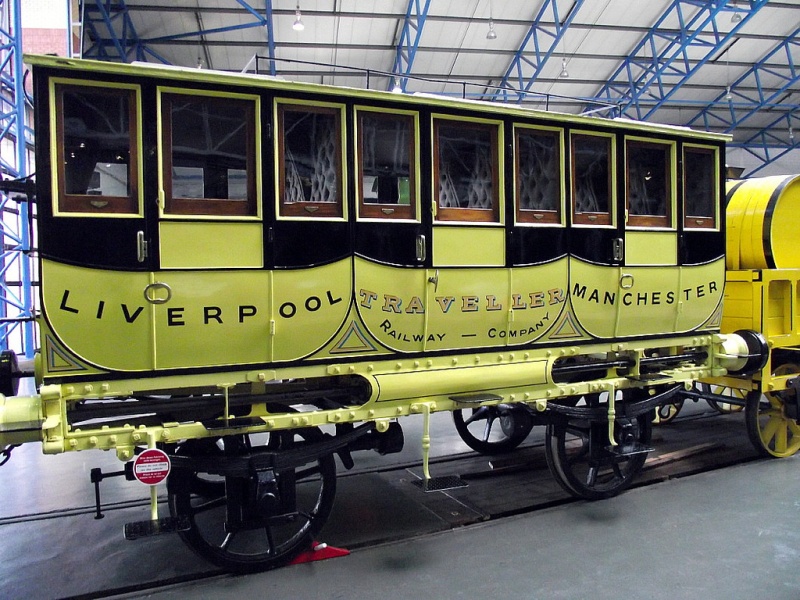
Above: replica Liverpool and Manchester
Railway first-class carriage on display at the National Railway
Museum, York.
Below: perhaps a little cramped, nonetheless 1st-class passengers
travelled in comparative comfort.
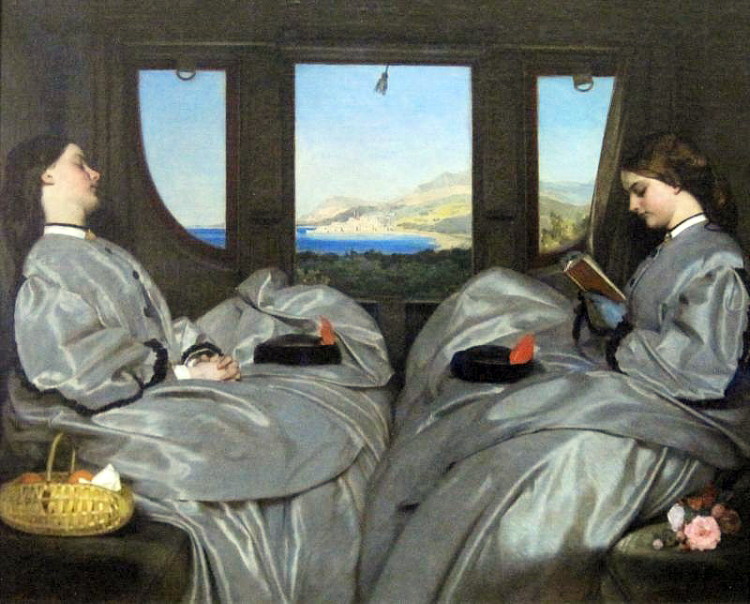
Timetables show that when the line was first opened there was only
two classes of travel. First-class carriages
looked much like three stagecoach bodies mounted on a common
chassis. Judging by the Liverpool and Manchester railway example
on display at the National Railway Museum, passengers travelled in
comfortable conditions, if rather cramped by modern standards. In his Road Book of
the London and Birmingham Railway, James Drake describes what a first-class passenger could expect
in 1839:
“Upon examining the internal
fittings up of the carriages, upon which so much of the comfort of
his journey will depend, the traveller will find that the first
class carriages are divided into three entirely distinct
compartments, and these compartments into six divisions (except in
the mails in which there are only four) so that each traveller has
an entire seat to himself, in which he can recline as freely and
comfortably as in the most luxurious arm chair; and after the shades
of evening have gathered over the scenery, can read the news of the
day, or turn over the pages of our little volume by the light of a
lamp, which is fixed in the roof of the coach.”
Second-class, however, sounded grim, especially for those
travelling in the ‘day coaches’ (see below) in a cold, wet and windy
weather, and to exacerbate their
discomfort the horse-hair buffers between coaches would have added
jolts to the noise and vibration from travelling over rails laid on
stone block sleepers:
“The second class carriages are,
however, of a very different character. These cushionless,
windowless, curtainless, comfortless vehicles, seem to have been
purposely constructed so that the sweeping wind, enraged at being
outstripped in his rapid flight, might have an opportunity of
wreaking his vengeance upon the shrinking forms of their ill-fated
occupants. At night, however, the partnership of the railway with
Messrs. Rheumatism and Co. is dissolved, and even second class
passengers are provided with shelter from the cold and chilling
blast.”
|
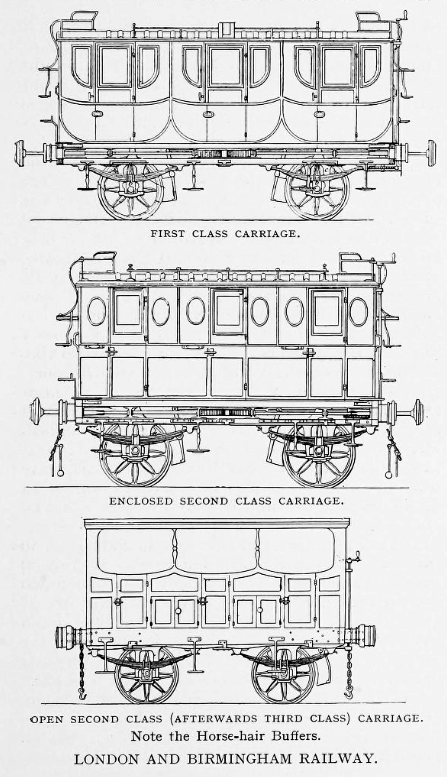 |
|
Note the roof
luggage racks and the outside seats for
the guards. |
In
The Iron Road Book and
Railway Companion, Francis Coghlan offers helpful advice
to those unfortunate second-class passengers:
|
“In the second-class carriages, or
rather waggons, there is certainly a preference to be observed. In
the first place, get as far from the engine as possible ― for three
reasons:― First, should an explosion take place, you may
happily get off with the loss of an arm or a leg ― whereas if you
should happen to be placed near the said piece of hot machinery, and
an unfortunate accident really occur, you would very probably be
‘smashed to smithereens’ . . . . Secondly ― the vibration is
very much diminished the further you are away from the engine.
Thirdly ― always sit (if you can get a seat) with your back
towards the engine, against the boarded part of the waggon; by this
plan you will avoid being chilled by a cold current of air which
passes through these open waggons, and also save you from being
nearly blinded by the small cinders which escape through the funnel.” |
When the Company introduced third-class travel, passengers in that
social strata inherited the second-class day coaches, leaving
second-class passengers at least the comfort of compartments
enclosed from the elements.
Most of the Company’s
railway carriages at this date were built by Joseph Wright, formerly a London
coach builder, who in the early part of the 19th century was both
contractor to the Royal Mail and owner of most of the stagecoaches then running between London and Birmingham. Wright was a man
of outstanding ability and foresight. Having closely watched the
birth and early development of the railways, he realised that the
stagecoach era was drawing to a close. In the early 1840s he began
to manufacture railway carriages utilising his company’s
skill and experience of coach building to the full, as is evident from some
of his early railway carriage designs:
“The Company’s establishment at
Euston Station, which is therefore principally for the maintenance
of carriages of various descriptions running between London and
Birmingham, consists of a large area termed ‘the Field,’ where
under a covering almost entirely of plate-glass, are no less than
fourteen sets of rails, upon which wounded or spare carriages lie
until doctored or required. Immediately adjoining are various
workshops, the largest of which is 260 feet in length by 132 in
breadth, roofed with plate-glass, lighted by gas, and warmed by hot
air. In this edifice in which there is a strong smell of varnish,
and in the corner of which we found men busily employed in grinding
beautiful colours, while others were emblazoning arms on panels, are
to be seen carriages highly finished as well as in different stages
of repair. Among the latter there stood a severely wounded
second-class carriage. Both its sides were in ruins, and its front
had been so effectively smashed that not a vestige of it remained. The iron-work of the guard’s step was bent completely upwards, and a
tender behind was nearly filled with the confused debris of its
splendid wood-work ― and yet, strange to say, a man, his wife, and
their little child, who had been in this carriage during its
accident, had providentially sustained no injury.”
The London Quarterly Review,
Volume LXXXIV (1849).
As early as 1844, Wright patented improvements to railway carriages,
in which 4, 6 and 8-wheeled bogies appeared, ideas that in many
respects were 50 years in advance of general carriage-building
practice. |
|
Some depictions of early railway travel,
from the Illustrated London News, 1847 . . . .
‘Epsom races’
|
|
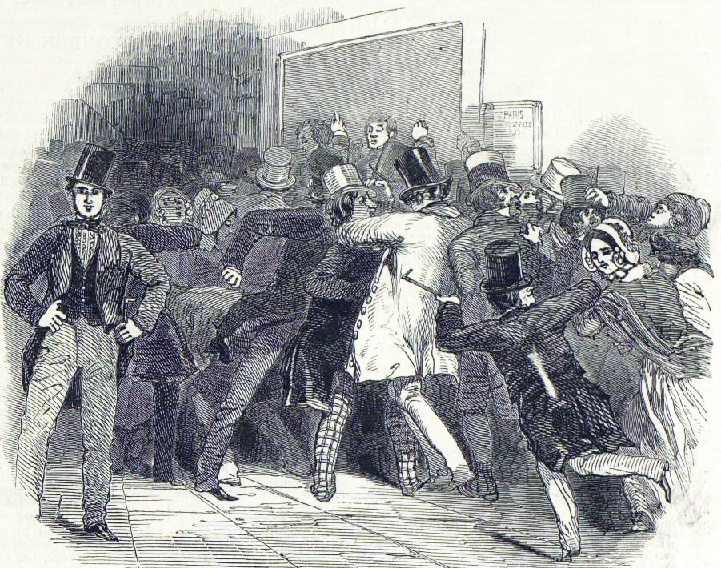 |
|
The ticket office. |
|
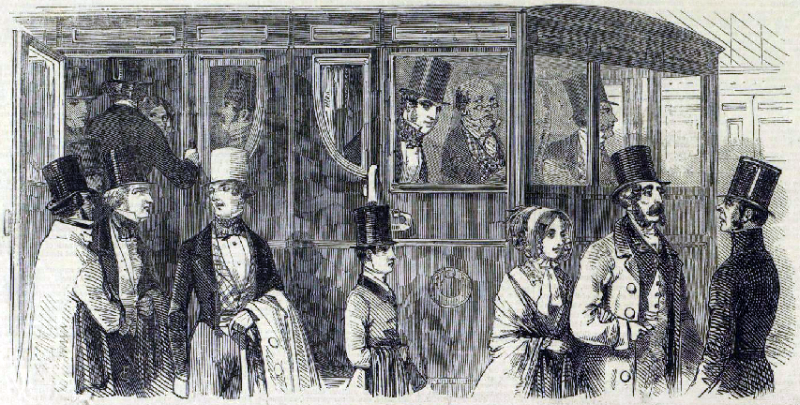 |
|
First-class. |
|
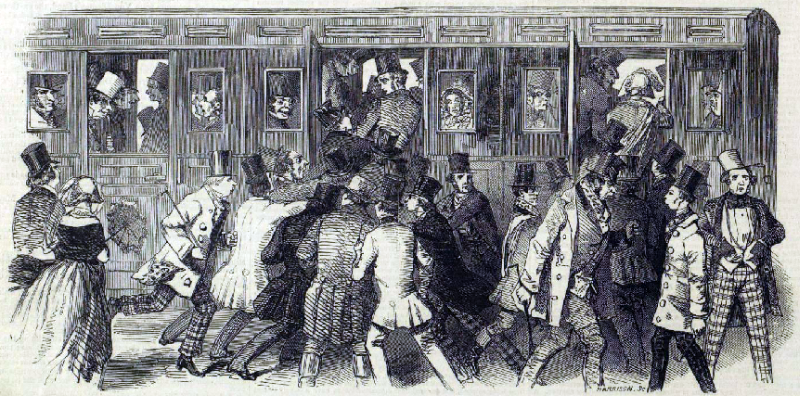 |
|
Second-class. |
|
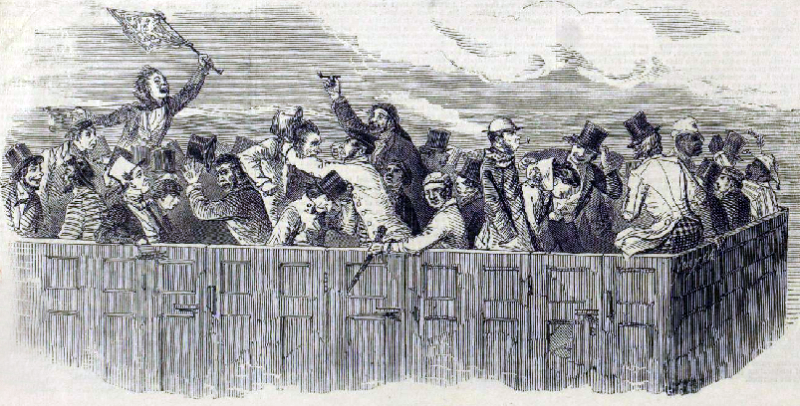 |
|
Third-class. |
|
As the railways grew, the demand for rolling stock was such that
Joseph Wright decided to build a new factory where more space was
cheaply available. Lying at the confluence of the London &
Birmingham, the Grand Junction and the Birmingham & Derby Junction
railways, among others, and in a position in close proximity to the
coal and iron districts, Birmingham was a good location.
In 1845, he leased land at Saltley on which to build his new
factory, which, when completed, contained “the
newest and most expeditious mechanical appliances”
and consisted of “workshops,
offices, a wharf and other buildings”
and included “engines, boilers
and other machinery”.
After becoming established at Saltley, Wright disposed of his works
in London. When he died in 1859, the business was continued by his
son Joseph under its original name until, in 1862, it became the
‘Metropolitan Railway Carriage and Wagon
Company Ltd’. The firm later became
part of ‘Metro-Cammell’,
and today is a constituent
of the Alstom group.
An unusual class of passenger soon to be conveyed in the
carriages of the London and Birmingham Railway was
the military ― probably the only instance of passenger traffic being
won from the Railway’s competitor, the Grand Junction Canal Company,
who had formerly undertaken troop movements. In early Victorian England, there were
very few police forces to
suppress civil unrest, and when such action was felt necessary, the Government and factory owners
called in the
army, the Peterloo Massacre (Manchester, 1819) being the most
notorious occasion. The year 1842 is believed to be the
first in which the new railway system was used to deploy troops to
quell civil unrest ― the picture below shows troops marching through the
Euston Arch amidst a throng of jeering protesters toward the train
that will take them to Manchester.
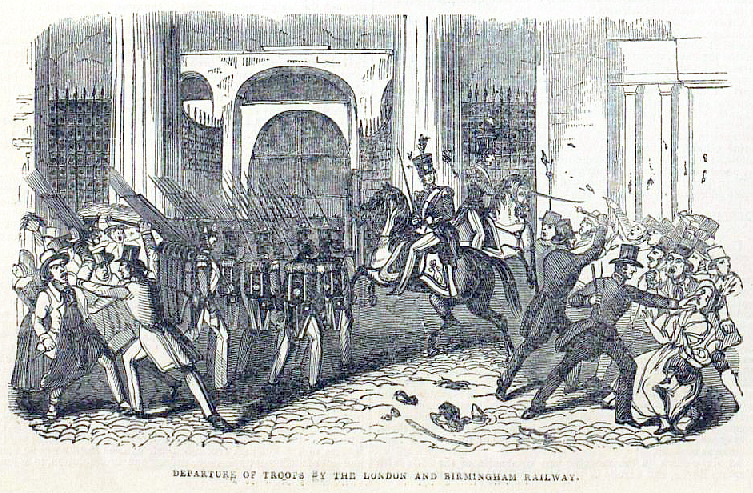
Troops marching through Euston’s
Doric Arch, en route to Manchester,
The Illustrated
London News, 20th August 1842.
The reason for this particular troop movement is tied up with the
political situation of the day, particularly the lack of voting
rights ― very few men and no women were entitled to vote at
elections. Out of this injustice emerged the ‘Chartist’
movement, its name being derived from the formal petition or ‘People’s
Charter’ that listed the movement’s main aims:
1. a vote for all men (over 21);
2. the secret ballot;
3. no property qualification to become
an MP;
4. payment for MPs;
5. electoral districts of equal size;
6. annual elections for Parliament. |
Support for Chartism peaked at times of economic depression and
hunger, and 1842 was a time when many working-class people
badly wanted political reform. Unemployment and near-starvation
brought rioting to Stockport and to Manchester, where workers
protested against wage cuts. Other areas most affected were the Midlands,
Lancashire, Cheshire, Yorkshire, and the Strathclyde region of
Scotland. With Chartist activists in the forefront, demands
for the provisions of the Charter to become law were included with
economic demands. The Government’s reaction was to send in the army to stamp out the
unrest, the troops
being conveyed to the scene of action by train:
“Immediately after the conclusion of the
deliberations of the Cabinet Council, which occupied upwards of two
hours, orders were forwarded from the Horse Guards to Woolwich, for
a party of of the Royal Artillery to hold themselves in instant
readiness to depart for Manchester; and a similar order was
despatched to St. George’s Barracks, Charing-cross, for the
departure of the third battalion of the Grenadier Guards, stationed
at that barracks, for the same destination, via the London and
Birmingham Railway . . . . About six o’clock a detachment of 150 of
the Royal Artillery left Woolwich, having in charge four heavy
pieces of ordnance, each drawn by four horses, and accompanied by
numerous waggons, containing ammunition, baggage, stores, and
accoutrements, under the command of Lieutenant-Colonel Smith, and
proceeded at the terminus of the London and Birmingham
Railway . . . . LONDON AND BIRMINGHAM
RAILWAY, SUNDAY,
― This morning, as early as nine o’clock, another troop of Royal
Horse Artillery arrived from Woolwich at the Euston Station of the
London and Birmingham Railway, with three field pieces and
ammunition. About 4 o’clock, the Quartermaster of the 34th Foot,
from Portsmouth, attended by an orderly, arrived, and ordered
refreshment to be procured from the various public-houses for that
regiment, which was en route by the South Western Railway from
Portsmouth. The great excitement at this time prevailed, the
Quartermaster being obliged to be escorted from the various
public-houses by the police. In an hour after, two waggons, laden
with ammunition and guarded by several soldiers of the 34th came up,
and was shortly after followed by the regiment, under the command of
Colonel Airey, consisting of 600 men. On their arrival they were
greeted the the most discordant yelling by the mob, and it was as
much as the police could do to prevent them from forcing an entry
into the railway yard.”
The Illustrated London News,
20th August 1842.
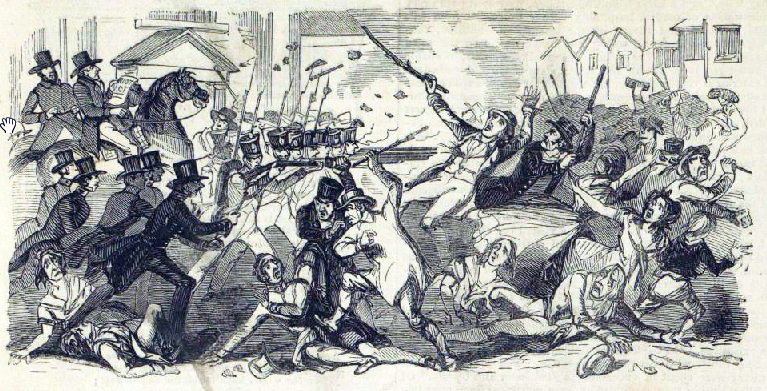
Troops firing on protesters at
Preston.
The Illustrated
London News, 20th August 1842.
But in general, the early travel writers were complimentary
about the treatment they received on arriving at Euston, albeit from
the Company’s officials rather than
a howling mob. The following is a
typical introduction to Euston Station:
“On arriving in a cab at the Euston
Station, the old-fashioned traveller is at first disposed to be
exceedingly pleased at the new-born civility with which, the instant
the vehicle stops, a porter opening its door with surprising
alacrity, most obligingly takes out every article of his luggage;
but so soon suddenly finds out that the officious green,
straight-buttoned-up official’s object has been solely to get
the cab off the premises, in order to allow the string of variegated
carriages that are slowly following to advance; in short, that while
he was paying to the driver, say only two shining shillings, his
favourite great-coat, his umbrella, portmanteau, carpet-bag, Russia
leather writing-case, secured by Chubb’s patent lock, have all
vanished; he poignantly feels like poor Johnson, that his ‘patron
has encumbered him with help;’ and it having been the golden maxim
of his life never to lose sight of his luggage, it gravels and
dyspepsias him beyond description to be civilly told that on no
account can he be allowed to follow it, but that ‘he will find it on
the platform;’ and truly enough the prophecy is fulfilled; for there
he does find it on a barrow in charge the very harlequin who whipped
it away, and who, as its guardian angel, hastily muttering the words
‘Now, then, Sir!’ stands beckoning him to advance . . . .
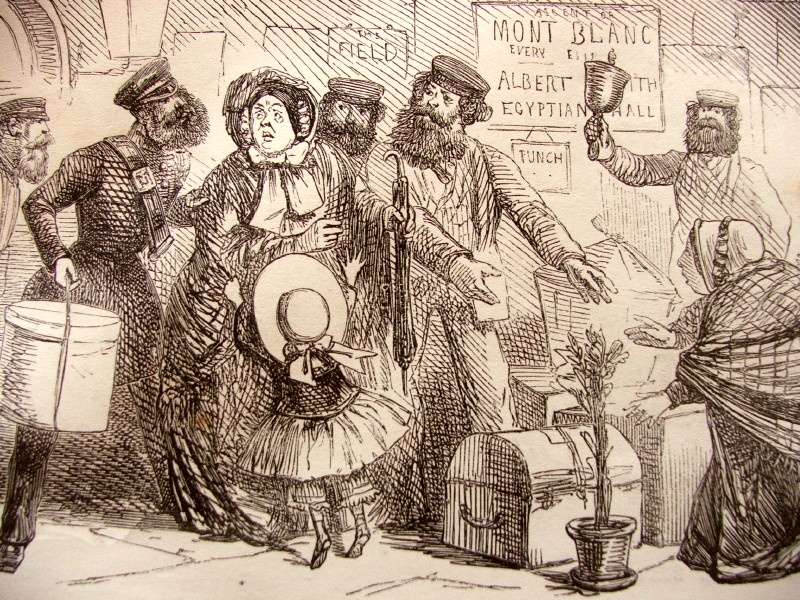
Now them ma’am, is this your
luggage?
A John Leech cartoon from Punch.
When every person has succeeded in
liberating himself or herself from the train, it is amusing to
observe how cleverly, from long practice, the Company’s
porters understand the apparent confusion which exists. To people
wishing to embrace their friends ― to gentlemen and servants darting
in various directions straight across the platform to secure a cab
or in search of private carriages ― they offer no assistance
whatever, well knowing that none is required. But to every passenger
whom they perceive to be either restlessly moving backwards and
forwards, or standing still, looking upwards in despair, they
civilly say ‘This way Sir!’ ‘Here it is Ma’am!’ ― and
thus, knowing what they want before they ask, they conduct them
either to the particular carriage on whose roof their baggage has
been placed, or to the luggage van in front of the train, from which
it has already been unloaded onto the platform.”
The London Quarterly Review,
No. CLXVII. (1849).
――――♦――――
ASHLIN BAGSTER AND ADMINISTRATION
The names of several people who played some part in the
early history of the London and Birmingham Railway crop up, and then disappear
just as suddenly. Peter
Lecount (whose name peppers these pages) is one such person,
another is Ashlin Bagster.
If a large organisation is to achieve its
business objectives
it requires an administrative system ― a bureaucracy
if you like ― through which the board can
exercise control. The London and
Birmingham Railway Company was no exception and it is in this
context that the name of Ashlin Bagster appears fleetingly.
Had he lived beyond his thirtieth birthday he might ― as the two
references to him suggest ― have achieved great things in railway
company administration.
|
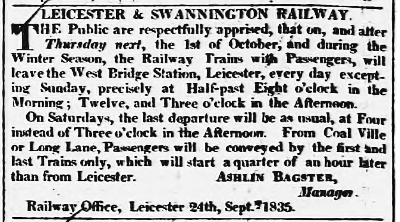 |
|
Leicester Journal,
25th September 1835. |
While still in his early twenties, Ashlin Bagster was appointed
Manager of the 16-mile Leicester and Swannington Railway.
Engineered by Robert Stephenson and opened in 1832, the line was
essentially a colliery railway built to serve local pits, but it
supplemented its modest income by carrying passengers.
Following a level crossing collision between a locomotive and a
cartload of farm produce, Bagster suggested to George Stephenson
that locomotives be fitted with steam whistles, and Stephenson
duly patented his ‘steam trumpet’. It is to Stephenson that credit for the
invention of the steam locomotive whistle is generally given.
Bagster appears to have been sufficiently efficient in his role for
Robert Stephenson to suggest his appointment as General Manager of
the London and Birmingham Railway, a considerable
advance in status:
“We may, in the course of this work, digress a little upon the
effects which this new system of travelling will produce; but we do
not propose to stop here, further than to notice that the whole code
of laws regulating the immense machinery of the passenger traffic of
this vast undertaking, may be said to have emanated from Ashlin
Bagster, Esq., a gentleman who holds the appointment of agent to the
Company for this department of traffic; and under whose management
we have no doubt, from his talents and the experience he possesses
in such undertakings, the most beneficial results will accrue to the
shareholders of the concern; whilst the public will have every
reason to find that their comfort and safety have been alike
provided for.”
The London and Birmingham Railway, Roscoe
and LeCount (1839).
Much of Bagster’s correspondence survives in the National Archives.
The index to the collection alone makes interesting reading, for it
illustrates succinctly the wide diversity of subjects that Bagster
was called upon to deal with. The following are just a few
examples:
|
CORRESPONDENCE |
|
4.1.1837 |
Two
receiving houses for parcels in London needed. |
|
23.1.1837 |
The parcels
vans cost £35-£40 each, we need three. Tarpaulins are
required to protect luggage on the roof. |
|
9.5.1837 |
12 feet
turntables delivered. |
|
27.6.1837 |
We have no
drawbar chains to any of the coaches. |
|
19.7.1837 |
The sidings
and turnpoints at Boxmoor are decidedly backward. |
|
21.7.1837 |
re erecting
of small dwellings at each road station. |
|
24.7.1837 |
Method of
accounts presentation. |
|
26.7.1837 |
Application
to sell newspapers at stations. |
|
7.8.1837 |
O’Connor
the constable fined 20/- by the Magistrates for being
drunk. |
|
24.8.1837 |
476 sheep
successfully loaded as trial from Boxmoor. |
|
26.8.1837 |
Complaints
of derailments and damage. |
|
4.9.1837 |
Intoxicated person injured jumping out of train to
rescue hat. |
|
4.9.1837 |
Application from porter whose arm was fractured between
buffers and amputated. |
|
25.9.1837 |
Derailment of passenger train near Harrow road gates. |
|
1.10.1837 |
Is the Parcels Office to open on Sundays? |
|
27.2.1838 |
Bye laws notices to be framed and exhibited. |
|
2.3.1838 |
Inspectors are selected from the most deserving of the
police. |
|
13.5.1838 |
Report two cows killed on the line. |
|
1.8.1838 |
Report of station clerk bad conduct and was dismissed. |
|
25.8.1838 |
Report lighting the mail and second class carriages ―
cost of lamps. |
|
12.9.1838 |
Fish traffic ― our proposed charge is 1½d a pound. |
|
18.9.1838 |
Re additional clerks, and salary increases for junior
clerks etc. |
Taking one letter from the bundle, Bagster wrote to the Company
Secretary, Richard Creed, on the 20th April 1837, asking him to
bring to the Committee’s attention the following “principal
preliminary arrangements for the conveyance of passengers”, on
which he awaited top management decisions:
Passenger fares, and whether the trains are intended to travel in
classes, or mixed carriages.
Fares of children under 10 years of age.
Weight of luggage to be allowed to each passenger.
Rate for conveying 4 wheeled carriages.
ditto 1 horse 4 wheeled and gigs.
Arrangements for persons [travelling] in their own vehicles.
Rate for conveying 1 horse or pony.
ditto two
ditto three (one truck will contain three
horses.)
Scale of rates for conveyance of parcels.
Protecting notice boards, and boards of rates.
Numbering of carriages, and whether to extend to any, but the first
class coaches, lighting of the coaches by lamps.
Admission of coaches into station yard.
Mode of appropriation of area in front of station.
Organisation of police force, on station and the line.
Appointment of clerks, guards (2 to each train), porters,
gatekeepers, enginemen, firemen and bankriders.
Uniforms of guards, policemen and porters.
Supply of gas (of gasometer).
Supply of water.
Clocks and bells to announce starting.
Office fitting, safes, heating apparatus.
Insurance of buildings and carriages.
Hours of departure
Sunday travelling
City receiving house for parcels.
Charge for booking or delivering parcels.
In the same letter, Bagster suggested to the Committee that the
following “should form part of the general regulation of traffic”:
No gratuity permitted to attendants.
Smoking prohibited on the station, or in carriages.
No dogs admitted (not even lap dogs).
Applicants intoxicated to be excluded.
Passengers behind time, to have half fare returned, if on same day.
Passengers losing tickets to pay again.
Trains never to stop but at fixed stations.
Company’s servants or their friends, prohibited travelling free on
the railway.
Bagster did not remain with the Company for long. He
left to take up an appointment as Manager of the North Midland
Railway, but his tenure there was also short lived, for he died in July
1839.
“I was introduced to Mr. Ashlin Bagster, who had been appointed,
at the nomination of Mr. Robert Stephenson, to be the first manager
of the London and Birmingham line: a tall and serious-looking
gentleman, who shook his head when, at his bidding, I copied a
letter as a specimen of my hand-writing. I was, however, appointed a
cadet in his office at a salary of twenty pounds per annum; the
first clerk to the first manager of the railway! . . . . The
details of the preparation for the opening fell upon Mr. Bagster, at
a salary of £400 per annum, and his small band of assistants at
Euston, at salaries from £20 to £150. This gentleman provided many
of the methods and forms which were adopted afterwards by most of
the railways, and which still remain in use. Of those who took part
in the preparations only a few rose to distinction in the
development of railways. Mr. Bagster left the London and Birmingham,
and took service on a northern line, but died early . . . .”
Fifty years on the London & North Western
Railway, by David Stevenson (1891).
――――♦――――
THOMAS EDMONDSON AND THE RAILWAY TICKET

A booking office.
When the Railway first opened, from the passenger’s
perspective the method of booking a seat remained virtually
unchanged from the stagecoach era ― indeed, that was the
origin of the term ‘booked’:
“Passengers were ‘booked’
just as they were for the stage coaches, and their names and
destination all written in the book, and it was some
considerable time before tickets were introduced; everything
connected with the passenger department was copied from the coaches,
and for some time a trumpeter played a tune on the horn as the
trains departed from the terminal stations.”
History of the London and North-
Western Railway, Wilfred L. Steele (1914).
Steele is here referring to the Liverpool and Manchester Railway,
but in Fifty Years on the London and North-Western Railway
David Stevenson gives a similar description of London and Birmingham
practice, although by the time the Railway had opened throughout the system appears to have been
somewhat streamlined by the use of colour-coded tickets:
“On paying your fare at either of the
Booking offices in London or at the stations, tickets are given,
coloured according to the class carriage you are going in. In London
they give pink for the first class, white for the second: along the
line, and at Birmingham, the colours are ― first class, yellow,
second, blue.”
The Iron Road Book and Railway
Companion, Francis Coghlan (1838).
Colour coding assisted aspects of railway accounting and made what
today is referred to euphemistically as ‘revenue protection’ easier
for the ticket inspector:
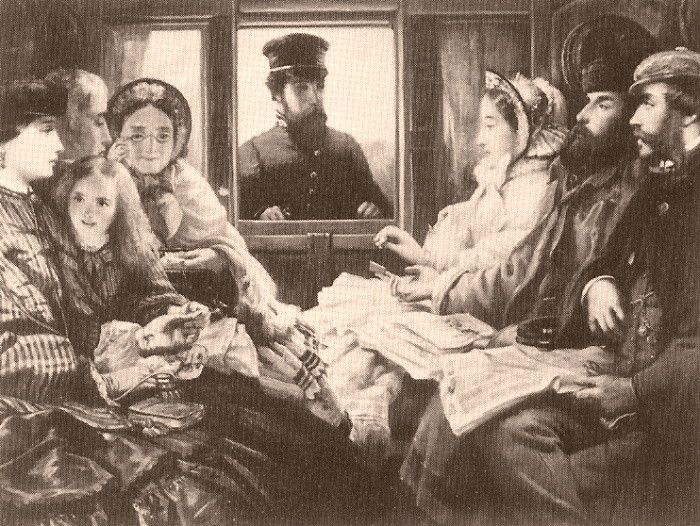
“The tickets, which should be of different
colours for up and down, and for each class of carriage, should be
collected by the guards from the passengers at the last station
before the termination of their journey, the upper guard taking the
first class, and the under the second class, a ticket collector
accompanying the upper guard to receive the tickets and money where
excess fares occur, and a trusty porter doing the same with the
under guard. The tickets, when collected, should be given to the
head booking-clerk for assortment, and by him sent to the principal
office the following morning, except where passengers get down at
any out-station, in which case their tickets are to be collected by
a man stationed for that purpose at a wicket, where only one person
can get through at a time; and the collector must see that each
ticket is issued to take the bearer to the station where he has got
down. When passengers are going from this last station to the
terminus, they should all be put in the carriages previous to the
guard going round to collect the tickets, that he may get theirs
also.”
A Practical Treatise on Railways,
Peter Lecount (1839).
|
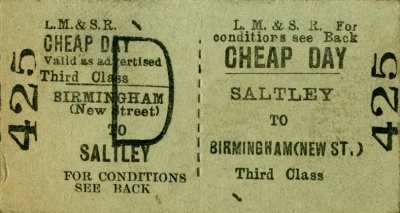 |
|
An Edmondson Ticket. |
Two further important refinements were soon made to the ticketing system. The first to arrive, in 1839, was the
‘Edmondson railway ticket’, which
formed the basis of a system for recording the
payment of railway fares and accounting for the revenue received.
It was the brainchild of Thomas Edmondson (1792-1851), who introduced
it on the Manchester and Leeds Railway to replace the stagecoach system, by
which a booking clerk wrote out a ticket ― name, destination and fare ― in
manuscript for each passenger, the counterfoil being retained in the booking
office. While this long-winded task was being performed, long queues formed at busy stations.
The pre-printed Edmondson tickets ― a card cut to 1 7⁄32 by 2 1⁄4 inches, with a nominal thickness of 1⁄32
inches ― were not only faster to issue, but their serial numbers provided
accountability, since, at the end of each day, ticket clerks were required to
reconcile their takings against the serial numbers of the unsold tickets.
This
prevented unscrupulous clerks from pocketing the fares. Tickets of
different types and to different destinations were stored in racks within a lockable cupboard, where the lowest remaining number of each issue was visible. Different
colours and patterns helped distinguish the different types of tickets, which
were date-stamped on issue.
|
|
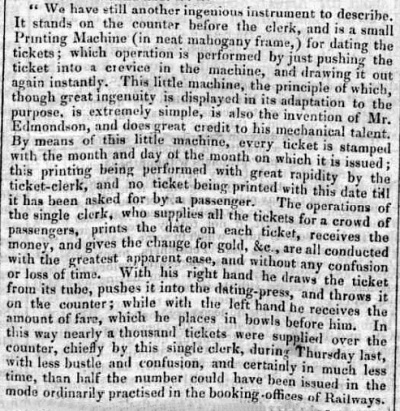 |
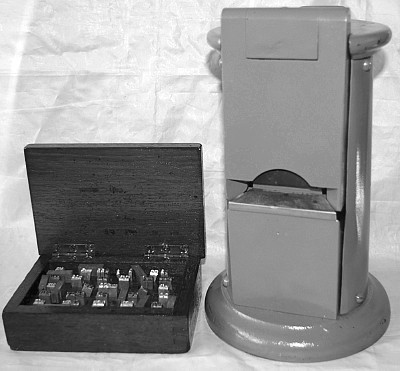 |
|
Carlisle
Journal, 31st August 1839. |
Edmondson-type ticket
dating machine and box of date stamps. |
|
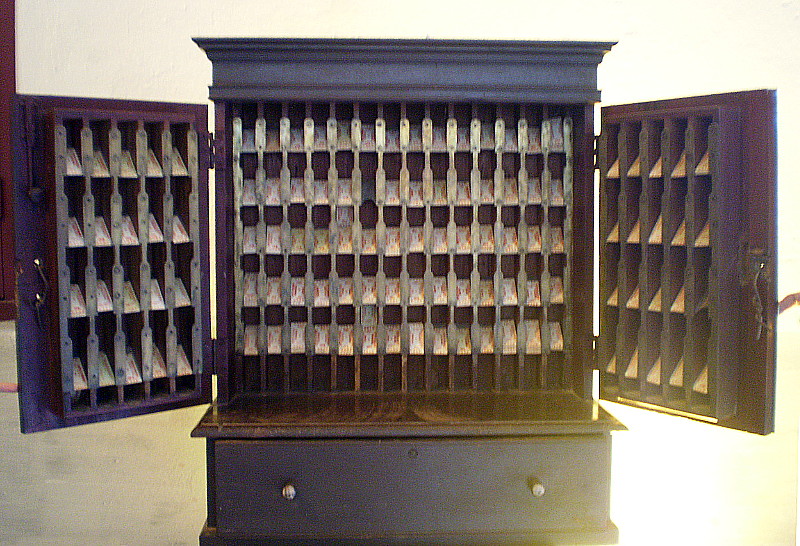
Example of an Edmondson cabinet and ticket
storage racks.
――――♦――――
THE RAILWAY CLEARING HOUSE
The Edmondson ticket did not enter widespread use until after the
creation of the second important refinement in the ticketing system,
the ‘Railway Clearing House’. This organisation was set up to manage the allocation of passenger and
freight revenue collected by railway companies for journeys that were to be
made, in part, over the lines of different companies.
The Edmondson system coped well with ticketing and accounting for journeys made over a single company’s
system, but as the railway network grew, single journeys became longer and
inevitably crossed the boundaries of other railway systems. Thus, ‘through
charging’ became desirable to avoid passengers having to
re-book their journey wherever this occurred, a requirement that applied equally
to freight. [2] A system was therefore required to
enable passenger and freight revenue to be divided equitably between the various
railway companies that
had provided whatever resources were necessary to complete a journey.
|
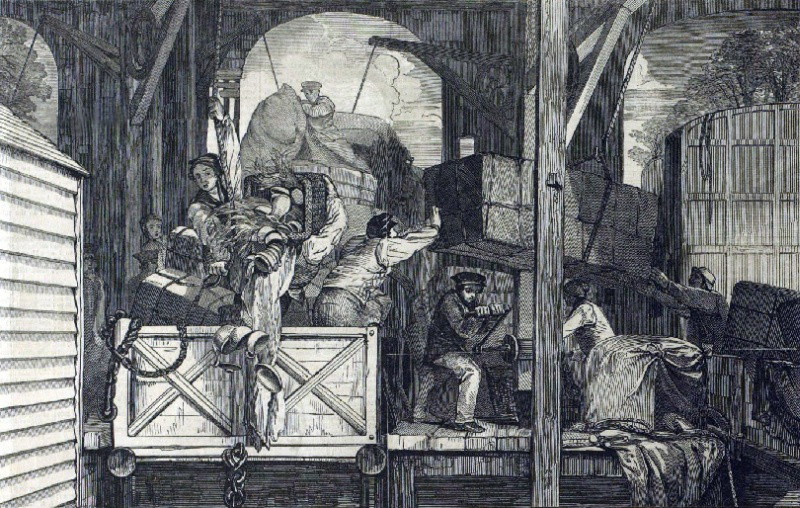 |
|
These two illustrations
show the mayhem that resulted during the transhipment of
goods and passengers at Gloucester, where Brunel’s broad gauge met the standard gauge.
However, they also illustrates the problem resulting
from the absence of ‘through charging’ arrangements
between adjoining railway companies, which the Railway
Clearing House resolved.
|
|
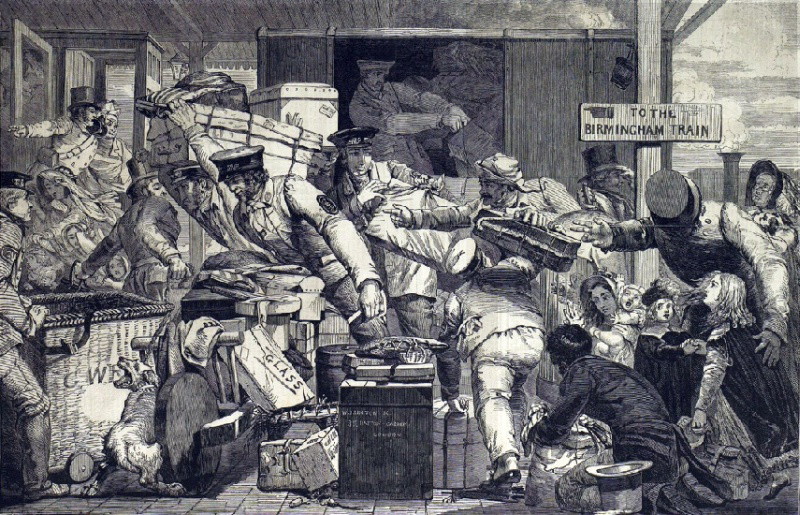 |
In 1842, an
idea that originated within the audit department of the London and Birmingham
Railway led to the formation of the Railway Clearing House (RCH):
“As the railways had not adopted a uniform
system of keeping their accounts, the division of these receipts led to much
controversy between the different lines, and this, in many instances, delayed
the introduction of through facilities. Accordingly, it occurred to Mr. Morison,
an audit clerk [3] on the
London and Birmingham Railway, that if a Clearing House, on the model of the
Bankers’ Clearing House, was established,
and authorised to divide all the through receipts between the different railways
on an uniform system, it would put an end to the bickerings between the
companies, and at the same time lead to the introduction of many new facilities. Mr. Morison brought his scheme to the notice of Mr. Glyn, the Chairman of the
London and Birmingham, and the latter enthusiastically took up the idea, with
the result that in 1842 the Railway Clearing House was started, under the
auspices of nine companies, with Mr. Glyn as Chairman, and Mr. Morison as its
first manager.”
The History of the London & North Western
Railway, Wilfred L. Steel (1914).
In years to come, the RCH was to have enormous impact in enabling the smooth
operation of inter-company accounting and the prompt settlement of outstanding
balances ― it was in the processing of passenger transactions that the
Edmondson ticket came into its own, eventually becoming adopted universally.
Initially, the RCH handled traffic receipts for the through conveyance of goods,
passengers, parcels and live stock between London and Darlington in one
direction, and between Manchester and Hull in the other. Nine railway companies
were admitted to participate in the business, these being the London and
Birmingham, Midland Counties, Birmingham and Derby Junction, North Midland, Hull
and Selby, Manchester and Leeds, Leeds and Selby, York and North Midland, and
Great North of England. By 1845, membership had increased to sixteen companies
operating 656 route-miles of track. In 1842, receipts were £193,246; by
1876, they were upwards of £16,000,000; and by 1933, £34,000,000. [4]
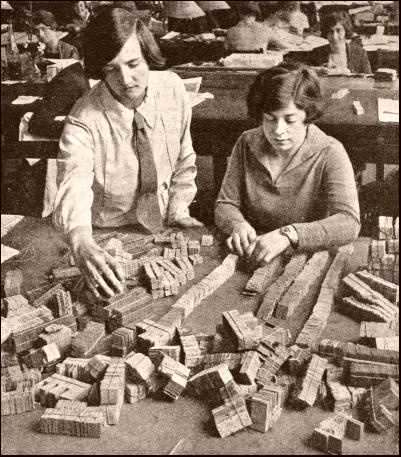
“The traffic returns of the different railway
companies were checked at the Railway Clearing House. The (Edmondson) tickets
surrendered to the collectors at the end of journeys were despatched to the RCH
each month. This illustration shows how they are sorted into order so that the
returns may be checked.”
From Railway Wonders of the World, July 1935.
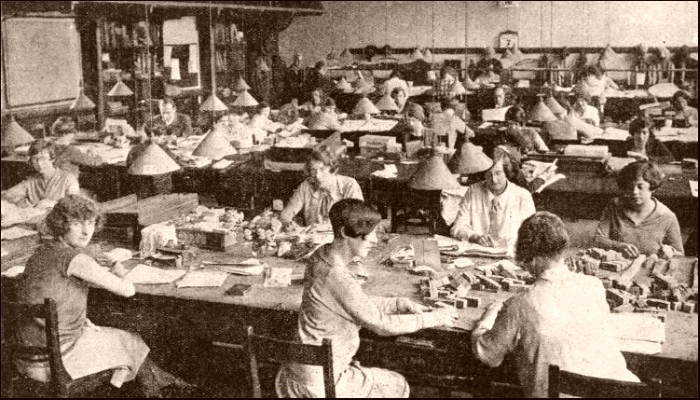
Sorting railway tickets in the Railway Clearing
House c.1935.
“A
prospective passenger can walk into any station booking-office in Great Britain
and purchase a ticket for practically any other station in the country ― and
that ticket will take him right through to his destination, irrespective of the
ownership of the lines over which he may have to travel.”
From Railway Wonders of the World, July 1935.
So important did the RCH become, that its function became enshrined in law, first
in ‘The Railway Clearing Act (1850)’,
the preamble to which succinctly states the organisation’s
purpose:
XXXI. ― CLEARING HOUSE.
13 & 14 Vict., Cap. xx xiii.
An Act for regulating legal Proceedings by or against the Committee of Railway
Companies associated under the Railway Clearing System, and for other Purposes.
[25th June, 1850.]
Whereas, for some Time past, Arrangements have subsisted between several Railway
Companies for the Transmission without Interruption of the through Traffic in
Passengers, Animals, Minerals, and Goods passing over different Lines of
Railway, for the Purpose of affording, in respect to such Passengers, Animals,
Minerals and Goods, the same or the like Facilities as if such Lines had
belonged to One Company; which Arrangements are commonly known as and in this
Act are designated as the ‘Clearing System’
and which Arrangements are conducted under the Superintendence of a Committee
appointed by the Boards of Directors of such several Railway Companies, which
Committee is in this Act designated ‘the
Committee;’ and the Business of such Committee
has heretofore been and is now carried on at a Building appropriated for the
Purpose in Seymour Street
[now Eversholt Street] adjoining the Euston Station of the
London and North-western Railway Company: And whereas the Clearing System
has been productive of great Convenience to the Public, and of a considerable
Saving of Expense in the Transmission of Passengers, Animals, Minerals, and
Goods over the Lines of the Railway Companies Parties to such Association; but
considerable Difficulty has been experienced in carrying into the Objects of the
Association, in consequence of the Committee not possessing the Power of
prosecuting or defending Actions or Suits, or taking other legal Proceedings:
And whereas George Carr Glynn, Esquire, is the present Chairman,
Kenneth Morison is the present Secretary, of the Committee: And whereas the
Purposes aforesaid cannot be effected without the Authority of Parliament: May
it therefore Your Majesty that it may be enacted and be it enacted; That the
several Companies which at the Time of the of this Act are Parties to the
Clearing System, and every other Company which shall in manner hereafter become
Party to the same, shall be subject to the Provisions of this Act.
Further Acts followed, the main purpose of the of the ‘Railway
Clearing Committee Incorporation Act’
(1897) being to incorporate the RCH and . . . .
“To confer upon the Railway Clearing
House as so incorporated, the power of acquiring, holding, receiving,
possessing, and disposing of lands and other property, and of suing and being
sued, and prosecuting and defending criminal proceedings, and all other usual
and incidental rights, powers, .and privileges of a corporate body.”
The London Gazette, 24th November 1897.
――――♦―――― |
GOODS TRAFFIC

|
The 1836 Act empowered the Company to carry goods in a manner
similar to that of canal companies. Canal companies provided a
waterway on which, for payment of a toll, carriers’ barges could ply laden with
goods that they had contracted to carry. Generally speaking, the
businesses and carriers that used the canals provided their own
wharfs, docks and warehouses. [5] In a
similar manner, the
London and Birmingham Railway Company Act
envisaged that the carriers would bring in the business and that the Company would charge them a toll
for the use of the line, the rate depending on the type of freight
and distance carried. It would also provide
the locomotives and wagons and, for an extra charge, warehouse facilities:
“CLXXI. And be it further enacted, That all
Persons shall have free Liberty to pass along and upon and to use
and employ the said Railway, with Carriages properly constructed as
by this Act directed, upon Payment only of such Rates and Tolls as
shall be demanded by the said Company, not exceeding the respective
Rates or Tolls by this Act authorized, and subject to the Rules and
Regulations which shall from Time to Time be made by the said
Company or by the said Directors, by virtue of the Powers to them
respectively by this Act granted . . . .
“CLXXIV. And be it further enacted, That it shall be lawful for the
said Company and they are hereby empowered to provide locomotive
Engines or other Power for the drawing or propelling of any
Articles, Matters, or Things, Persons, Cattle, or Animals, upon the
said Railway, and to receive, demand, and recover such Sums of Money
for the Use of such Engines or other Power as the said Company shall
think proper, in addition to the several other Rates, Tolls, or Sums
by this Act authorized to be taken.”
3 GUL. IV. Cap. xxxvi. RA 6th
May 1833.
The provision of locomotives was extended in the second Act to
include wagons:
“CXIX . . . . That it shall be lawful for the said Company to
provide or hire, use and employ, locomotive Engines or other Power,
Coaches, Waggons, and other Carriages, and with such locomotive
Engines or other Power, Coaches, Waggons and Carriages, or any other
Coaches, Waggons, and Carriages, to carry and convey, as well upon
and along the said Railway as upon and along any other Railway or
Railways, all such Articles, Matters, or Things, Persons, Cattle, or
Animals, as shall be offered to them for that Purpose, and to make
such reasonable Charges for such Carriage or Conveyance not
exceeding the Amount specified in the said recited Act, as they may
determine on . . . . ”
5 & 6 Gulielmi IV. Cap. lvi.
RA 3rd July 1835.
Thus, in conformity with the Acts’ provisions . . . .
“. . . . The system adopted by the London
and Birmingham Company was the open one of allowing all carriers to
use the line. The railway company stipulated that they should supply
the locomotive power at agreed rates, and that for the use of the
road certain tolls should be levied. [Appendix II.]
These constituted the whole and sole account between the company and
the carriers. The latter collected and delivered the goods, took all
risks upon themselves, and provided they paid to the railway company
its dues, every needful facility was given to them to carry on their
business. The tolls and haulage rate were so regulated, that whilst
on the one hand they contributed a handsome profit to the railway
exchequer, they were on the other sufficiently reasonable to allow
the carriers to conduct their business to a profit. In this there
was mutuality -- an essential ingredient in all business
arrangements. The competition amongst the carriers was the security
which the public had against unfair charges.”
Railway Management, John
Whitehead (1848).
However, the open competition carrying system used by the London
and Birmingham was not adopted universally:
“An opinion pretty extensively prevails
that the railway companies are the carriers of goods on their own
railways; but this is true only to a partial extent. Three modes of
proceeding are adopted by different railways in this respect: ―
1.
as on the Grant Junction Railway; the Company being their own
carriers: 2. as on the London and Birmingham Railway; the Company
having nothing to do as carriers, but allowing the regular carriers
to use the railway on payment of a certain toll: 3. as on a few
minor railways in the north of England, where both the other systems
are combined, the Company and the carriers competing one with
another. The comparative advantages and disadvantages of these three
systems form an intricate subject, into which we do not propose to
enter; both in committee-rooms of the House of Commons and in courts
of law, questions of much difficulty have arisen in respect of one
or other of these systems. It happens, however, that on the railway
which forms the great artery between the metropolis and the
manufacturing districts, viz., the London and Birmingham, the system
of open competition is adopted; and the very nature of this
competition, coupled with the immense extent of the daily traffic to
the metropolis, render this railway a peculiarly advantageous one
for watching the communicating machinery which links the Manchester
or Birmingham manufacturer with the London warehouseman or
merchant.”
Penny Magazine, Volume 2,
edited by Charles Knight (1842).
The practice adopted by the Grand Junction Railway, from Birmingham
northwards (referred to at 1. above), was to employ a large
carrying firm, Chaplin & Horne, as
their goods agent, on terms more favourable than those they applied
to Pickfords and to other carriers on the line. However, this
arrangement ignored the terms of the Grand Junction Railway’s Act, which
required that there be equal charging. The long-established firm
of Pickfords contested this practice in
court, and although they won their case with costs, the Grand Junction Railway Company
simply ignored the court ruling and continued as before.
In 1839, Joseph Baxendale, a director of Pickfords, was appointed
Goods Superintendant of the London and Birmingham Railway. He set up his office at Camden Station and undertook to design the layout of the Camden goods depot:
“He was cheerful and witty in conversation,
ever had a word of encouragement for the youngsters, and was
universally beloved by those whom he employed. The success of
Pickford & Co., and the general efficiency of that establishment,
proved his administrative power; and his foresight and wisdom at
this critical time for carriers were borne out by eminent results. His clear system of forms and arrangements, by which a hold of the
goods conveyed is maintained from the time they leave the consignor
until they reach their destination, continues to be the basis of the
carrying-business all over the kingdom.”
Fifty Years on the London & North
Western Railway, David Stevenson (1891). |
|
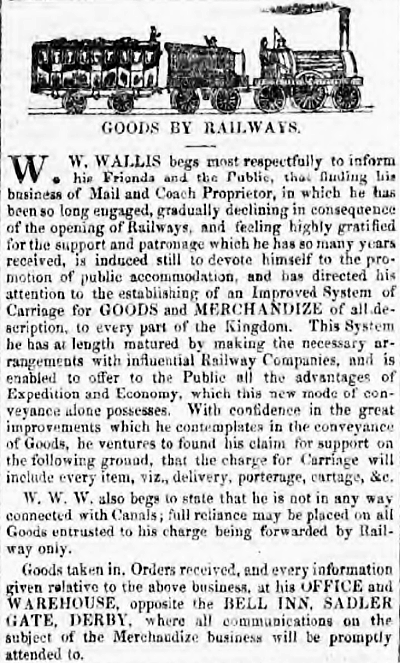 |
|
Derby Mercury,
18th November 1840.
A mail coach proprietor switches businesses. |
Once the Railway became operational, the task facing the Company was to
assist the
carriers to bring in sufficient business to
yield a favourable return on the huge investment made in building and
equipping it:
|
“Sheds were erected for the large carriers,
for which they paid a rental; and Pickford & Co. built their own
premises, adjoining the station, on land purchased by Mr. Baxendale
years before, in anticipation. Chaplin & Horne became Goods agents
for the Grand Junction Railway Co., and had also suitable
accommodation provided for them at Camden. The Company provided
waggons which they placed in a siding, from whence the carriers
turned them into their respective sheds. Occasionally the Company
supplied tarpaulins for the waggons, for which a charge was made.”
Fifty Years on the London & North
Western Railway, David Stevenson (1891). |
But when it came to the Railway capturing trade from the established carriers, goods
differed from passengers in one important respect. Although
the subject of much complaint over their monopolistic charges and
poor service (indeed, it was these failings that
provided the business case for building the Liverpool and Manchester
Railway), the canal companies nevertheless offered a well-established means
of transporting goods, particularly the deadweight cargoes of coal,
stone and manure ― of which a great quantity had to be disposed of
from the streets of the horse-powered Metropolis. Furthermore,
to minimise their transhipment costs many businesses at both ends of the supply chain
were located near canal-side wharfs, docks and warehouses, and they were loath to abandon
their investment in setting up a system that worked tolerably well, at least
until the benefits from switching to rail transport became
undeniable. Thus the railway companies faced a greater challenge in
capturing goods traffic from the canals than they did in
capturing passenger traffic from the stagecoach operators, who could not
compete with the superior speed and relative comfort of rail travel.
Wherever a railway opened, the existing coach operators either went
out of business immediately, or transformed themselves into a
railway feeder service. |
|
While the line was still under construction, the Company lacked the
capacity to operate a partial goods service in the same way that it
operated such a service for its passengers. As a temporary
measure, when it reached
Wolverton, Pickford was allowed to use the line to enable the firm’s canal traffic to bypass the
summit of the Grand Junction
Canal at Tring, which was then closed through drought. Because Baxendale, in his role as
the Railway’s Goods Superintendent, did not grant this
facility to all, there was furore among the other carriers who
wrongly believed that the Company had entered into a exclusive
carrying agreement with Pickford & Co. This resulted in a
petition being presented to Parliament protesting about the
Company’s action:
|
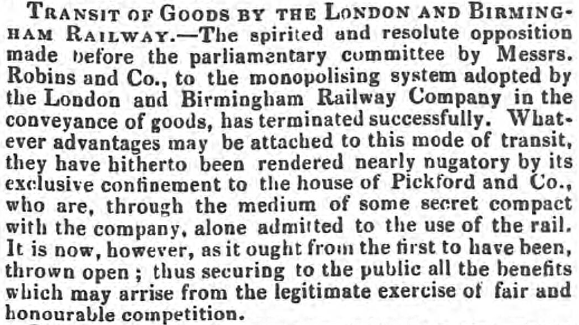 |
|
Blackburn
Standard, 3rd April 1839. |
From April 1839, the Company opened the line to
all carriers, although it was used mainly by the large operators, Pickford and Chaplin & Horne:
“The goods traffic was commenced by the
transfer of some of Messrs. Pickford & Co.’s extensive canal traffic
to the line, and a small temporary loading-shed was built for the
purpose, in 1839. The old waggon sheds were removed, and an
adequate workshop for the construction of waggons was erected . . .
. Further steps were taken to improve the goods traffic. A Goods
Committee of Directors, with Captain Moorson for Chairman, was
appointed; that gentleman having become a Director . . . . Mr.
Wyatt, from Pickford & Co’s establishment, was made the Goods
Manager, and the Company began to carry on toll for some of the
important carriers, in addition to Pickford and Co. Mr. Baxendale,
at this time, resigned the superintendence of the line, and was
succeeded by Mr. H. P. Bruyeres, a late Officer of Engineers. The
goods traffic progressed but slowly, however, although inducements
were offered to road and canal carriers to transfer their business
to the railway.”
Fifty Years on the London & North
Western Railway, David Stevenson (1891).
In 1839, Baxendale bought a plot of land on the south side of the
Regent’s Canal adjacent to the Railway bridge. On this site he
built a warehouse, to a design by Lewis Cubitt, for the transhipment
of goods between road, rail and canal. A railway bridge was
erected
over the Regent’s Canal to provide a direct rail connection between
the warehouse and the Camden
goods depot. The warehouse was opened in December 1841.
Around this
time, Thomas Mills succeeded Baxendale as Goods Manager, and
he set about reducing freight tolls in an effort to capture traffic from the
canals.
Despite a slow start, by 1843 the Company Secretary was able to
report increased traffic in merchandise and cattle, and the Company was soon making progress in
developing the goods sector of its business ― even if the outcome was
occasionally unexpected:
“The cattle traffic necessitated the erection of a large
cattle station at Camden. The animals, who always, in their
excitement, ran the wrong way, often escaped on to the main line and
charged the trains, getting, of course, the worst of such encounters
. . . . A sharp watchman, in a dimly lighted goods shed at Camden,
once found a bear, which had escaped from Euston, crouching against
a waggon, and, taking it for a thief, he pounced upon it, but
retreated in dismay, unhurt. A hue-and-cry was raised, and poor
Bruin was captured, after a spirited chase. At another time a tiger
in a case fell from a load on to the railway. The fall smashed the
case, and the tiger trotted along the line. Some soldiers were
obtained from a neighbouring barrack and went in pursuit. They found
that the signalman had climbed a telegraph post to get out of the
way, but on nearing the tiger they discovered that they had marched
without ammunition, and the tiger fell to the gun of a gentleman who
lived near the spot. A case containing a crocodile similarly fell
from a train, and an inspector, walking the line, thought he was
nearing a man run over, but he speedily went back for assistance, on
arriving at the object of his attention.”
Fifty Years on the London & North
Western Railway, David Stevenson (1891). |
|
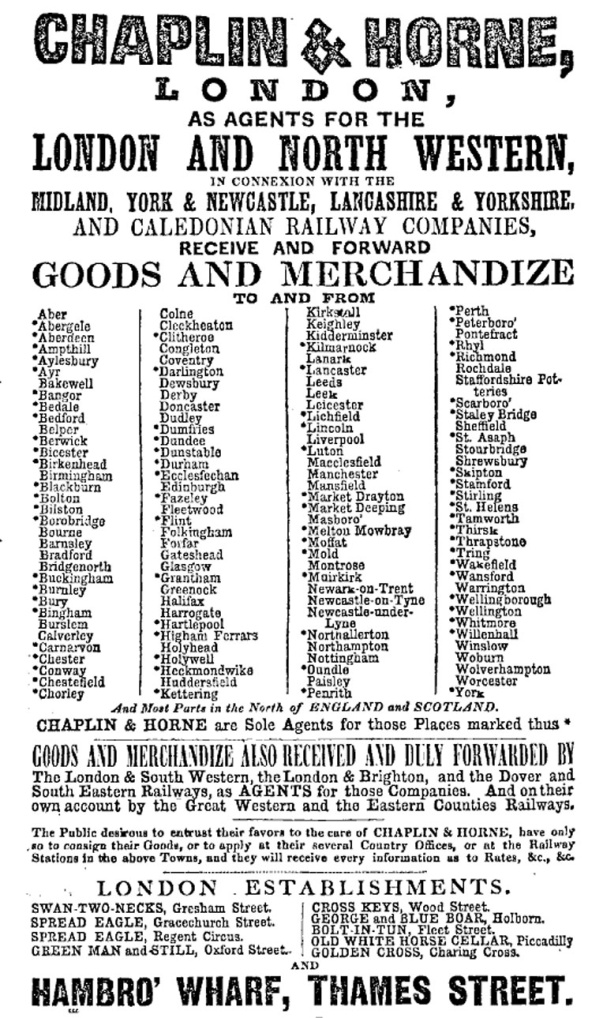 |
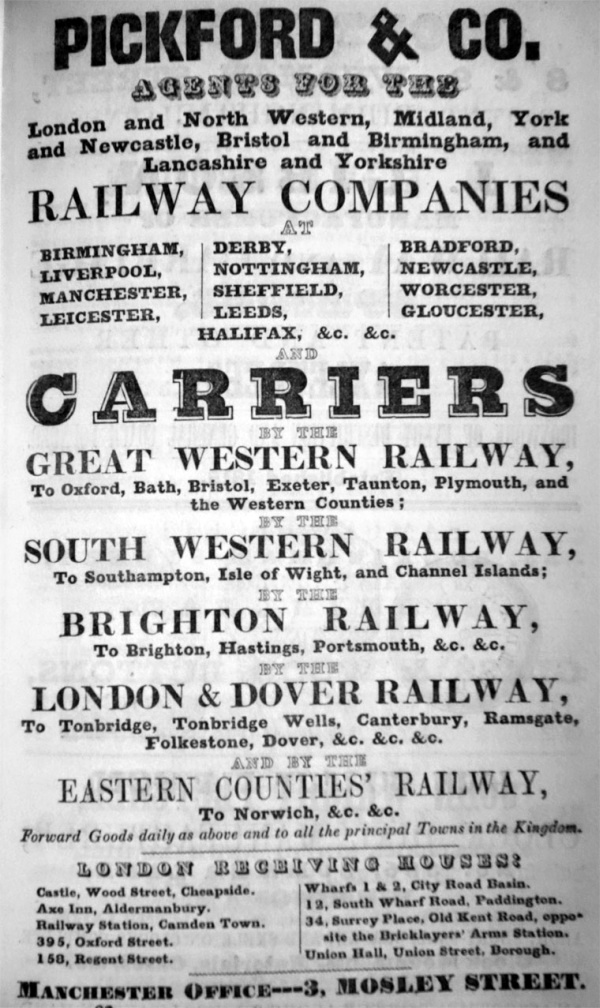 |
|
A Chaplin & Horne advertisement
from 1852. |
A Pickford advertisement from
1848. |
Following the railway company
merger in 1846, the newly formed London & North-Western Railway adopted the policy
followed by the Grand Junction on the carriage of goods, for it
was believed that the independent carriers were making excessive profits from
the reduced freight tolls then in force. The Company denied the
carriers access to its line and acquired their business:
“The London and North Western Railway
Company have, it is well known, thrown the carriers off their lines,
monopolizing the whole of the traffic themselves, and retaining the
more influential merely of the dispossessed carriers as agents,
upon condition that they further give up their canal traffic
whenever it is considered by the company to interfere with their
interests. In pursuance of this condition the parties so
retained by this company have since been obliged to cease carrying
upon canals; and the only employment they, therefore, now possess as
carriers is in conveying goods to and from the railway. Thus the
canals are in a moment deprived of their most enterprising and
wealthy traders, whose operations, together with their influence,
acquired principally upon this once flourishing field of enterprise,
and at a period before railways were in existence are thrown into
the scale of their monopolizing rivals.”
Hope for the Canals!
Thomas Boyle (1848).
The biographer
Samuel Smiles [6] listed, from the railway
companies’ perspective, the benefits to be had by acting as their
own carriers:
“The
recent arrangement adopted by railways, of becoming carriers on
their own account, has already worked greatly to their advantage. The carriers and their friends have complained, because the railway
companies have not continued no make over to them as formerly, the
large profits derived from carrying goods, preferring to retain them
for the benefit of the shareholders. The public are also benefited
by the new arrangement in the following respects: ―
lst. It secures greater punctuality in delivery. When a certain
quantity of goods is sent from one town to another, a truck can be
loaded expressly for that town; whereas when there were three or
four parties to convey the same goods, they were obliged to load
them to some intermediate place, there to be re loaded with a fresh
quantity of goods.
2nd. It secures the public against petty frauds. The carriers were
in the habit of charging what they could get.
3rd. It secures equality of charges to all parties.
4th. It facilitates the interchange of traffic; because it enables
merchants and others to ascertain exactly what the cost of transit
will be to any part of the kingdom.
5th. It facilitates the settlement of claims for loss or damage. Under the old system, it was difficult for a merchant to obtain a
settlement of these, because the company referred him to the
carriers and then again the carriers referred back to the railway
company, and so on, without any progress towards a settlement.
6th. It prevents disappointment in the delivery of goods. The
competition amongst the old carriers was so great, that they very
often gave promises which it was perfectly impossible to redeem.
As Mr Booth stated before the Railway Acts Enactments Committee, in
1846, the system of carriers carrying by railway was an exceedingly
injurious system ― ‘it was unsound in itself, and made the public
pay double profits to a middleman.’
In conclusion, it may be averred that the carriage of goods by
railways, is yet in its infancy, and that before many years are
over, by far the largest part of the revenue of all railways will be
derived from this source . . . .”
Railway Property: its condition
and prospects, Samuel Smiles (1849).
. . . . and in his conclusion, that goods revenue would
eventually predominate, Smiles was correct.
However, the L&NWR didn’t have sufficient
resources to cope with its burgeoning goods business, which resulted
in the Company reaching an agreement with Pickford to operate as a
goods agents. The Company acquired Pickford’s shed at Camden, which
it rented back to them, and, in 1847, as part of a deal to become a
L&NWR goods agent, Pickford gave up the greater part of its canal carrying
business.
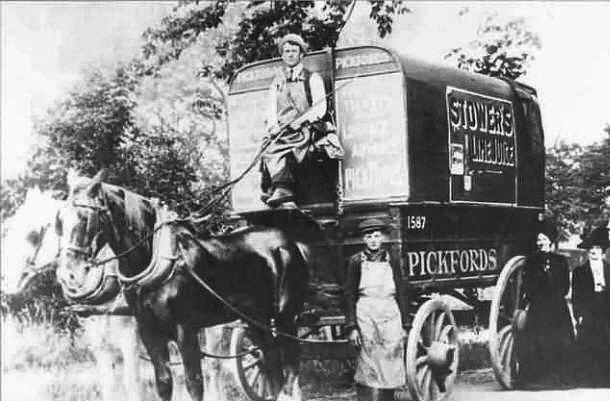
Following a slow start, by the end of the 1840s there had been a marked growth
in goods traffic on the railways in general, as
Smiles had predicted, and by 1852 goods receipts had overtaken those from
passengers. [7] In his book
Railway Economy, Lardner had already observed the growth of
goods receipts and a decline in those from passengers:
“I have already observed that the first projectors of the modern
railways contemplated chiefly, if not exclusively, a traffic in
merchandise. The event proved to be the reverse. The traffic in
merchandise was comparatively little, nearly the whole revenue
proceeding from the traffic in passengers. As the railways, however,
have become more extensively developed, and improvements have been
made in the machinery of locomotion, the goods traffic has been more
and more extended, so as to bear a continually increasing proportion
to the traffic in passengers. In order to demonstrate this, I have
exhibited in the following table an analysis of the relative amounts
of revenue proceeding from passengers and goods for the six years
and a half ending December 31st 1848.

“It appears from this, that while, in 1843, thirteen years
after the opening of the Liverpool and Manchester Railway, the goods
contributed only 30 per cent. of the gross revenue of the railways,
they contributed, in the eighteen months terminating December 30th
1848, more than 42 percent.”
Railway Economy: A Treatise on the
New Art of Transport, Dionysius Lardner (1850).
Speaking of the high throughput at the
Camden goods depot a decade after the London and Birmingham Railway
had opened, Frederick Smeeton
Williams had this
to say:
“The entire arrangements at this station,
for conducting the goods department of the Company, are on a
colossal scale; and this will not be surprising when it is stated
that the merchandise received from up and for down trains, averages
between eight and nine hundred tons a day. During the six months
ending the 26th of August, 1848, 73,732 railway-wagon loads of goods
entered and departed from Camden station; while, as a remarkable
illustration of the development of the latent resources of a great
country by cheapening traffic, the carriage performed by the Grand
Junction Canal, which meanders alongside its powerful antagonist,
has actually increased to a very considerable extent since the
opening of the London and Birmingham Railway.”
Our Iron Roads, by F. S.
Williams (1852).
As Williams states, the Grand Junction Canal did experience an
upturn in the tonnage carried, but the inland waterways were by now
in a state of commercial decline in the face of fierce railway competition.
――――♦―――― |
THE DECLINE OF CANAL COMPETITION
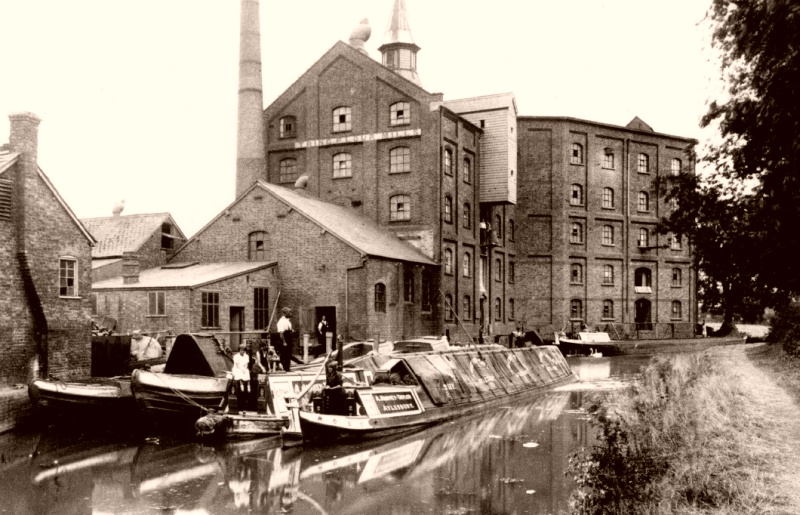
Tring Flour Mills on the Wendover
Arm, Grand Junction Canal.
In 1836, the Grand Junction Canal Company, the Railway’s main
competitor for freight, earned its peak annual revenue of £198,086,
undoubtedly boosted by the construction materials it was then
transporting to create its new neighbour with whom a price
war soon began. Before the Railway opened in
1838, the GJCC significantly reduced its monopolistic charges. Tonnage
rose in response, but the increase was insufficient to compensate
for the significant price reductions made to attract
it, and the GJCC’s fortunes fell into a decline [8]
from which they never recovered. [9] Data submitted in
1846 to the Select Committee on
Railways and Canals Amalgamation, shows the extent of the price reductions
per ton, brought about by railway competition, along the waterway between London and Langley Mill in
Derbyshire: [10]
|
|
Rates per ton which the canal companies were entitled
charge to under their Acts, and which they did charge. |
Reduced
rates after 1836: |
|
Grand Junction Canal, 97 miles: |
|
|
|
On Sundries |
16s 3¾d |
2s 0¼d |
|
On Coal |
9s 1d |
2s 0¼d |
|
|
|
|
|
Grand Union, 24 miles:
|
|
|
|
On Sundries |
6s 0d |
5½d |
|
On Coal |
2s 11d |
5½d |
|
|
|
|
|
Old Union, 19 miles:
|
|
|
|
On
Sundries |
4s 9d |
5½d |
|
On
Coal |
2s 1d |
5½d |
|
|
|
|
|
Leicester Nav., 16 miles:
|
|
|
|
On Sundries |
2s 6d |
4d |
|
On Coal |
1s 2d |
4d |
|
|
|
|
|
Loughboro’, 10 miles:
|
|
|
|
On Sundries |
2s 6d |
4d |
|
On Coal |
1s 2d |
4d |
|
|
|
|
|
Erewash, 11 miles:
|
|
|
|
On Sundries |
1s 0d |
4d |
|
On Coal |
1s 0d |
4d |
When Pickford retired from
canal carrying in 1847, the GJCC lost its major customer.
In an effort to retain Pickford’s
canal business, the GJCC itself entered the canal carrying business under
the terms of the Canal Carriers Act (1845):
“The canal companies having had a foretaste
of what was in store for them, applied to and obtained permission
from Parliament to become carriers on their own account ― a
privilege which up to that time they had not possessed. The result
has been that the Grand Junction Canal Company, to preserve itself
from destruction, is competing for the goods traffic between London
and the North at rates so low, that the railway company cannot
venture to touch them, much less to drive the canal company as
competitors from the field. When this unseemly strife will end no
man can foresee. Life and death are in the balance so far as the
canal company is concerned.
Some palliation for this ruinous and
reckless competition might have been found if the Railway Company
had been making profit by the trade which their low rates have
brought them, but the fact is so far otherwise, that a considerable
portion of the profit derived from passengers cannot fail to be
absorbed by the losses which are incurred in the conveyance of
goods.”
Uniformity of Railway
Accounts, George King (1849).
But for the Grand Junction Canal Company, canal carrying and price
reductions were to no avail. In the price war, the railways were
able to cross-subsidise loss-leading goods rates from their
profitable passenger account, a strategy not available to the Canal, and during the years that followed, the GJCC
gradually lost most of its long-distance traffic to its
railway competitors.
A measure of this decline can be seen in the amount of coal
shipped into London from the Midlands and North of England by canal
and railway respectively. The tonnages for the period between 1852 [11]
and 1882 show that the GJC’s share of this trade fell dramatically,
which is especially significant, for the transport of coal originally comprised a
large part of its business:
| |
1852 |
1882 |
|
By canal |
33,000 tons |
7,900 tons |
|
By
railway |
317,000 tons |
6,546,000 tons |
|
From the Report of
the Parliamentary Select Committee on Canals
(1883) |
When the Royal Commission on Canals sat in 1906, the figures
they were presented with for the weight of coal being shipped into
London were, by rail 7,137,473 tons (45.6%); by sea 8,494,234 tons
(54.3%); by canal 18,681 tons (0.119%); and overall for the period 1880 to
1905, 0.1% of the coal shipped to London came by canal, rail and
coastal shipping
sharing almost equal proportions of the balance.
This dramatic switch to the railways eventually left
the GJCC to concentrate on short-haul
traffic along the southern section of its waterway, which
continued to pay a modest return until the early 1960s, when road transport and factory
modernisation eventually killed the
remnants of that trade. [12]
――――♦―――― |
|
THE BRANCH LINES
During its brief life, the London and Birmingham Railway Company
acquired or built several branch lines. What follows is merely a
résumé
of the salient points, for each line is a study in itself:
“Opening of the Aylesbury Railway.–The
opening of the Aylesbury Railway took place on Monday last. It was
made, with reason, the occasion of a complete holiday by the
inhabitants of Aylesbury. At a very early hour in the morning, bands
of music paraded the streets, and led the way to the station,
whence, shortly after seven o'clock, a train, containing the
directors, shareholders, and friends, started for the terminus of
the branch near Cheddington. Trips to and from this point were made
throughout the day, at intervals of an hour and a half or two hours,
the carriages being on every occasion crowded externally as well as
internally with excursionists, including all "the beauty and
fashion" of Aylesbury and its vicinities. Nothing occurred to mar
the festivities of the day, which was delightfully fine.
About half-pest four, a deputation from the London and Birmingham
Railway Company accompanied the directors down the line, and a
dinner afterwards took place at the White Hart Inn. A display of
fireworks from the top of the County Hall closed the festivities.
During the whole of the day scarcely a shop was open in the town.
The line is about 7¼ miles in length, and is perfectly straight,
excepting only the curves at either terminus. There is neither
cutting nor embankment of any importance. The point at which it
enters the London and Birmingham line is about four mites North of
the Tring station, and 35 from London.”
Northampton Mercury,
15th June 1839
“While
the London and Birmingham Railway was thus improving its position in
the north, it was also developing in the south, for in 1845 it
absorbed two authorised lines, the Bedford Railway, a line projected
to connect Bletchley with Bedford, and the Dunstable Railway, a
railway proposing to connect Dunstable with the London and
Birmingham Railway at Leighton. While on the subject of absorbing
neighbouring companies, it may be mentioned that early in the next
year (1846) the Aylesbury Railway and the authorised but not
constructed Rugby and Leamington Railway were both added to the
London and Birmingham Railway’s
system.
In 1845, with a view to improving its position in the western
districts of London, the London and Birmingham Railway leased the
West London Railway, a railway which had been incorporated as early
as 1836 under the somewhat cumbrous title of Birmingham, Bristol and
Thames Junction Railway, and whose object was to connect the lines
of the London and Birmingham and Great Western Railways with each
other, and with Kensington, and also with the Thames by means of the
Kensington Canal, which it purchased for £36,000.”
The History of the London and
North-Western Railway, Wilfred L. Steel (1914).
The lines to which Steel refers, now mostly defunct, are:
1.
Opened in 1839, the 7-mile Aylesbury Railway linked the town with
the main line at Cheddington. Although a branch line ― plans to
extend it to Oxford never reached fruition ― it was built by an
independent railway company. In June 1844, the railway was leased to
the London and Birmingham Railway Company for a period of 7 years at
an annual rent of £2,000 and was eventually absorbed into the London
& North-Western Railway Company. It closed to passengers in 1953
and to goods in 1964.
2. Engineered by Robert Stephenson, the 44-mile Northampton and
Peterborough Railway was promoted by the London and Birmingham
Railway to run from a junction at Blisworth to Northampton and then
via Wellingborough, Thrapston, Oundle and Wansford to Peterborough. The Act received the Royal Assent in 1843; the first section of the
line opened from Blisworth to Northampton in May 1845, and
throughout in June, the 47 miles having taken only a year to build.
The line was closed to passengers in 1964, and closed throughout in
1972.
3. The Act authorising the Dunstable, and London and Birmingham
Railway (the Dunstable branch) received the Royal Assent on the
30th June 1845 and the 6¾-mile branch opened in May 1848. It closed
in 1962.
4. Surveyed by Robert Stephenson, work commenced on
the construction of the Bedford, London, and Birmingham Railway
(the Bedford branch) in December 1845, and the 15¾-mile line
opened on 17th November, 1846, with intermediate stations at Fenny
Stratford, Ridgmont, Lillington and Manston (later renamed
Millbrook). In 1850, the Buckinghamshire Railway opened a further
section between Bletchley and Verney Junction, and in the following
year the section between Verney Junction and Oxford. The Bedford and
Cambridge Railway opened in 1862.
The line once provided an important cross-country link between
Oxford and Cambridge, becoming known as the ‘Varsity Line’, although
passengers were required to change at Bletchley. During the Second
World War the line was heavily used, but after the war traffic
tailed off, especially when faster trains into London made for a
shorter journey time via the Metropolis. British Railways withdrew
the services between Oxford and Bletchley, and between Cambridge and
Bedford in 1967. The Oxford to Bicester section was re-opened to
passenger traffic in 1987, and there has been much discussion about
restoring part of, or even the entire Oxford to Cambridge rail link.
5. The Birmingham, Bristol and Thames Junction Railway ―
later to become the West London Railway ― was conceived to
link the London and Birmingham Railway and the Great Western Railway
with the Kensington Basin of the Kensington Canal, which it bought
in 1836, enabling access to and from London docks for the carriage
of goods. Opened in 1844, the line had stations at Kensington and
Shepherds Bush, an exchange platform at the point of crossing the
Great Western Railway main line and at the junction with the London
and Birmingham Railway. In 1846, the railway was leased to the
London and Birmingham Railway, but the railway/canal combination was
commercially unsuccessful. In 1863, the the railway was extended
southwards along the canal alignment as the West London Extension
Railway, crossing the Thames on a new bridge and connecting south of
the Thames with
both the London, Brighton, & South Coast Railway and the London &
South-Western Railway. Local and long-distance
passenger traffic was carried, and goods traffic exchanged between
the connected railways. Passenger traffic declined after 1940, but
the line remained open for sporadic freight services until the
1970s, when passenger use recommenced. Today, the West London
Line, now electrified (part 750V DC third rail, and part 25kV AC
overhead), links Clapham Junction in the south to Willesden Junction
in the north and carries both passengers and freight.
――――♦――――
POSTSCRIPT
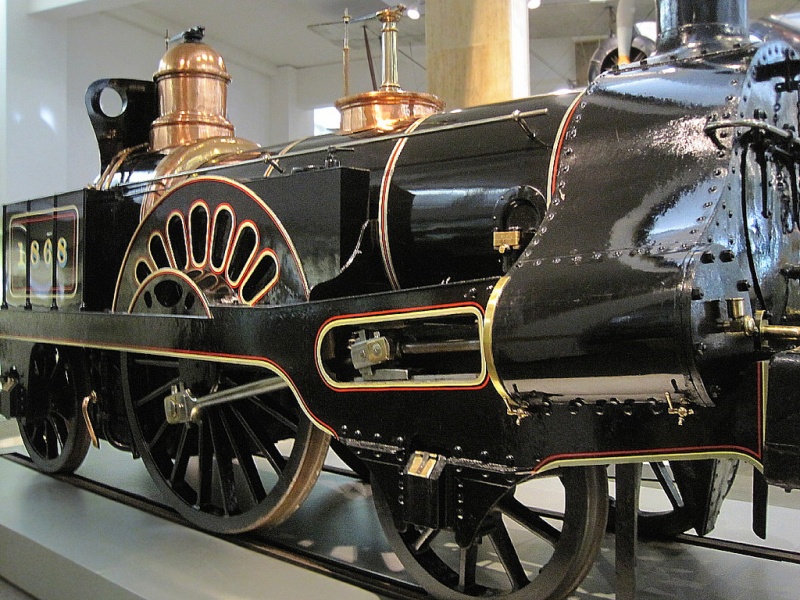
Grand Junction Railway locomotive
‘Columbine’ (built 1845), the Science Museum, London.
In 1846, the London and Birmingham Railway Company merged
with the Grand Junction and the Manchester and Birmingham railway
companies, to form the London and North Western Railway. By the late
19th century, the L&NWR had grown into the largest joint stock
company in the world. However, the great pressure placed on our
railway network during World War I., together with little opportunity
or resources for proper maintenance, left it in a sorry condition
and, when peace returned, it was losing money. The government of the
day aimed to remedy the situation by imposing a merger on most of
the 120 railway companies that then existed . . . .
“With a view to the reorganisation and more efficient and
economical working of the railway system of Great Britain railways
shall be formed into groups in accordance with the provisions of
this Act, and the principal railway companies in each group shall be
amalgamated, and other companies absorbed in manner provided by this
Act.”
From The Railways
Act 1921.
In 1923, four large railway companies were formed from this merger
in what became known as the ‘grouping’, the L&NWR becoming a
constituent of the newly formed London, Midland and Scottish (LMS) Railway, the
direct ancestor of today’s West Coast Main Line. During the
inter-war years, competition from road transport intensified while a
further lack of maintenance during World War II. again left our
railway system in a very run-down condition. Under Clement Atlee’s
Transport Act, the majority of the U.K.’s railways were nationalised
in 1947 (together with road transport, waterways and docks, all
coming under the unwieldy ‘British Transport Commission’), from which
emerged ‘British Railways’. Although from the travelling public’s
point of view controversial, British Railways did set about pruning
the deadwood (perhaps excessively!) and modernising our railway
network. The first section of the West Coast Main Line to be
electrified, from Crewe
to Manchester, was completed in September 1960, to be followed in
March 1967 by completion of the scheme to electrify the former London
to Birmingham Railway.
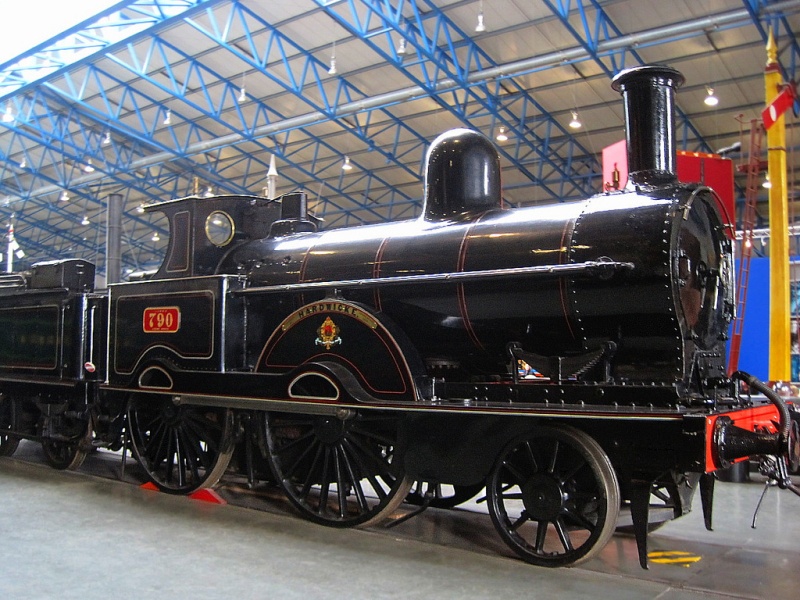
London & North-Western Railway 2-4-0
‘Hardwick’ (built 1892), National railway Museum, York. |
CHAPTER
14
――――♦――――
|
APPENDIX I.
ORDERS AND REGULATIONS
taken from
Cornish’s Guide and
Companion to the London and Birmingham Railway (1839).
For regulating the travelling upon and use of the said Railway, and
for and relating to travellers passing upon the said Railway, and
for preventing the Smoking of Tobacco, and the commission of any
other Nuisance in or upon any of the Carriages, or in any of the
Stations belonging to the said Company, and generally for regulating
the passing upon and using the said Railway.
I. No Passenger will he allowed to take his seat in or upon any of
the Company’s Carriages, or to travel therein upon the said Railway,
without having first booked his Place and paid his Fare. Each
Passenger hooking his Place will he considered as binding himself
and agreeing to abide by and observe these Rules and Regulations so
far as they concern himself: he will, on booking his place, be
furnished with a Ticket, which he is to shew when required by the
Guard in charge of the Train, and to deliver up prior to his
quitting the Company’s premises at the end of his journey. Any
Passenger refusing to produce, on request, or at the end of the
journey to give up, his Ticket, will be required to pay the Fare
from the place whence the Train originally started, or in default
thereof is hereby made liable to the Penalty of Forty Shillings.
II. Passengers at the Road Stations will only be booked
conditionally, (that is to say) in case there shall be room in the
Train for which they are booked; in case there shall not be room,
Passengers booked for the longest distance will be allowed the
preference. Passengers booked for the same distance will have
priority according to the order in which they are booked.
III. Any Passenger who shall have paid his Fare for a second-class
Carriage, and shall ride in or upon a first-class Carriage, shall
forfeit the Sum of Forty Shillings.
IV. Dogs will be charged for according to distance, but they will on
no account be permitted to accompany Passengers in the Carriages.
V. Smoking is strictly prohibited both in and upon the Carriages,
and in the Company’s Stations. Any Passenger persisting in Smoking
after being warned not to do sob is hereby subjected to a Fine of
Forty Shillings, and in case of his persisting after a second
warning, he will immediately, or (if travelling) at the first
stopping place, be removed from the Company’s Premises and forfeit
his Fare.
VI. Any Passenger in a state of intoxication, committing any
nuisance, or wilfully interfering with the comfort of other
Passengers, obstructing any of the Company’s Officers in the
discharge of their duty, or not attending to the directions of the
Guard, in cases where the personal safety of himself or any of the
Passengers is concerned, will be immediately removed from the
Company’s Premises, or in case he shall at the time be travelling,
then at the next Station, or as soon after the offence as
conveniently may be, and shall forfeit his Fare.
VII. Any Passenger wilfully cutting the Lining, removing or defacing
the number Plates, breaking the Windows, or otherwise damaging any
of the Company’s Carriages, shall he fined Five Pounds.
VIII. The charge made for Passengers does not extend to Luggage. The
Company will not in any case he answerable for Luggage, unless the
Passenger to whom the same belongs shall have booked and paid for
it; on booking, a Ticket will he given to the Owner, and a
corresponding Ticket affixed to the Luggage, and the Luggage will
only be delivered to the party producing such Ticket. A charge of
sixpence will he made for each Passenger’s Luggage not exceeding
112lbs. in weight for the whole distance, and an additional charge
of one penny per lb. above that weight. The attention of Passengers
is requested to the legal Notice exhibited in the Booking Offices,
limiting the Company’s responsibility for Luggage or Goods booked by
any of their Carriages.
IX. The Company’s Porters will render every facility to passengers
in loading and unloading Luggage at the different Stations. No Fee
or Gratuity is permitted to he taken by any of the Company’s
Servants under any circumstances whatever, under pain of instant
dismissal.
N.B. By the Act of Parliament above-mentioned after providing for
the Recovery of Penalties, and directing that one-half thereof shall
go to the Informer, and the other half to the Company, it is by the
211th Section enacted, ‘That it shall be lawful for any Officer or
Agent of the said Company, and all such persons as he shall call to
his assistance, to seize and detain any person whose name and
residence shall he unknown to such Officer or agent, who shall
commit any offence against this Act, and to convey him before some
Justice for the County, Liberty, or Place within which such offence
shall he committed, without any other warrant or authority than this
Act; and such Justice is hereby empowered and required to proceed
immediately to the hearing and determining of the Complaint.’
――――♦――――
APPENDIX II.
RATES AND TOLLS
(3 GUL. IV. Cap. xxxvi. RA 6th May 1833.)
CLXXII. And be it further enacted, That it shall be
lawful for the said Company to demand, receive, and recover, to and
for the Use and Benefit of the said Company, for the Tonnage of all
Articles, Matters, and Things which shall be conveyed upon or along
the said Railway, any Rates or Tolls not exceeding the following;
(that is to say,)
For all Dung, Compost, and all Sorts of Manure, Lime, and
Lime-stone, and Salt, and all undressed Materials for the Repair of
public Roads or Highways, the Sum of One Penny per Ton per Mile;
For all Coals, Coke, Culm, Charcoal, Cinders, Building, Pitching,
and Paving Stone, dressed; Bricks, Tiles, Slates, Clay, Sand,
Ironstone, Iron Ore; Pig, Bar, Rod, Hoop, Sheet, and all other
similar Descriptions of Wrought Iron and Castings, not manufactured
into Utensils or other Articles of Merchandize, the Sum of One Penny
Halfpenny per Ton per Mile:
For all Sugar, Grain, Corn, Flour, Dyewoods, Earthenware, Timber,
Staves, and Deals, Metals (except Iron), Nails, Anvils, Vices, and
Chains, the Sum of Two-pence per Ton per Mile:
For all Cotton and other Wools, Hides, Drugs, manufactured Goods,
and all other Wares, Merchandize, Articles, Matters, or Things, the
Sum of Three pence per Ton per Mile.
CLXXIII. And be it further enacted, That it shall be lawful
for the said Company to demand, receive, and recover, to and for the
Use and Benefit of the said Company, for and in respect of
Passengers, Beasts, Cattle, and Animals conveyed in Carriages upon
the said Railway, any Tolls not exceeding the following; (that is to
say,)
For every Person conveyed in or upon any such Carriage, the Sum of
Two-pence per Mile;
For every Horse, Mule, Ass, or other Beast of Draught or Burthen,
and for every Ox, Cow, Bull, or neat Cattle, conveyed in or upon any
such Carriage, the Sum of One Penny Halfpenny per Mile:
For every Calf or Pig conveyed in or upon any such Carriage, the Sum
of One Halfpenny per Mile:
For every Sheep, Lamb, or other small Animal, conveyed in or upon
any such Carriage, the Sum of One Farthing per Mile:
For every Carriage, of whatever Description, not being a Carriage
adapted and used for travelling on a Railway, and not weighing more
than One Ton, carried or conveyed on a Truck or Platform, the Sum of
Four-pence per Mile. |
――――♦――――
|
FOOTNOTES |
|
1. |
Parliamentary Papers,
House of Commons and Command, Volume 41 (1842). |
|
2. |
“When the Clearing House started business
it had been agreed that a mileage charge of ¼d a mile should be
levied on waggons travelling on ‘foreign lines’, the charge to apply
only to the outward loaded journey and not to the return journey to
base. In addition there was to be a charge of 6s a day
[later reduced to 3s] demurrage for
each day, other than the days of arrival and departure, that a
waggon was detained by a company other than its owner. These
regulations were made to ensure that scarce waggons were not taken
by unnecessarily long routes to their destination and were not
unduly detained or put to improper use by the companies that did not
own them.”
The Railway Clearing House in the
British Economy, p.62,
Philip Bagwell, Aberdeen University
Press, 1968. |
|
3. |
This accounts appears to demote Morison to a mere clerk ― other
accounts describe him as ‘Head of the Audit Department’, a far more
responsible position. |
|
4. |
The figures for 1876 are taken from ‘Somers Town and Euston Square’,
Old and New London: Volume 5 (1878). The figures for 1842 and
1933 are taken from Railway Wonders of the World, July 1935. |
|
5. |
The Canal Carriers Act (1845) permitted canal companies to become
their own carriers. Following Pickfords withdrawl from the canal
carrying business in 1847, the Grand Junction Canal Company took
advantage of the Act to create its own ‘Carrying Establishment’ ―
it was never that successful, and the GJCC gave up canal carrying in 1875. |
|
6. |
Samuel
Smiles (1812-1904) had a career on the railways, first as Secretary to the Leeds
& Thirsk and then to the South-Eastern railways, before turning his
hand to writing biographies of famous people, and books on self-help
and other morally uplifting subjects for which he is remembered
today. |
|
7. |
By the end of the century, passenger receipts were, with some exceptions in heavy commuter areas,
barely paying for the provision of the service and the most successful railway
companies were those with a solid business in freight, such as the
North Eastern railway. |
|
8. |
Coal, the Grand Junction Canal’s staple business, suffered badly following the
coming of the railways. In 1852, the GJCC carried
33,000 tons of coal into London; by 1882 this had fallen
to 7,900 tons. During the same period the various railway companies
serving London saw their coal traffic grow from 317,000 tons to
6,546,000 tons. From the Report of the Parliamentary
Select Committee on Canals, 1883. |
|
9. |
On
the Grand Junction Canal, following a slow decline in freight
tonnage over many years, carrying finally ceased in 1981 (the final
cargo being lime pulp from Brentford to Hemel Hempstead), although
little had been carried after 1964 when British Waterways withdrew from
the business. |
|
10. |
A route on which the canal companies
along the line had reached a tariff
agreement. Canal companies were not particularly good at
co-operation, let along amalgamation, both being factors that assisted in
their demise. |
|
11. |
There is no canal data available prior to 1852, but it can be
assumed by then that coal traffic on the GJC was already much
reduced from its peak, probably in the 1830s. Allowing for increased
consumption and for trade captured from coastal shipping, much of
the 317,000 tons of coal brought into London by rail in 1852 would
otherwise have come down the GJC. |
|
12. |
The decline of the Grand Junction Canal is described in more detail
in the companion e-book, A Highway Laid with Water (Chapter
XII. et seq). |
――――♦―――― |
